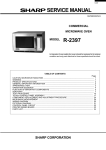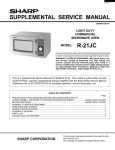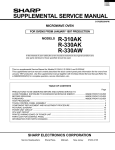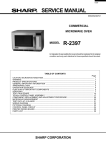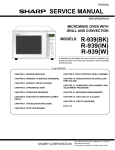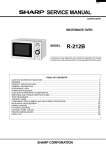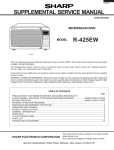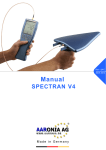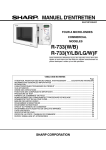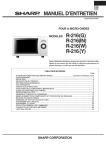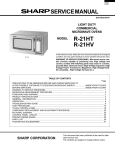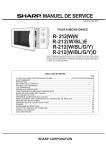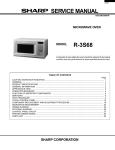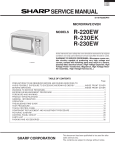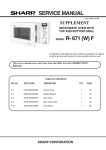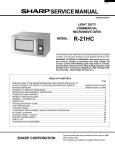Download SERVICE MANUAL R-2275 R-2285
Transcript
R-2275 R-2285 SERVICE MANUAL SY307R2395H// COMMERCIAL MICROWAVE OVEN MODELS R-2275 R-2285 In interests of user-safety the oven should be restored to its original condition and only parts identical to those specified should be used. TABLE OF CONTENTS Page CAUTION, MICROWAVE RADIATION ....................................................................................................... 1 WARNING .................................................................................................................................................... 1 PRODUCT SPECIFICATIONS ................................................................................................................... 2 GENERAL IMPORTANT INFORMATION ...................................................................................................3 APPEARANCE VIEW ................................................................................................................................. 3 OPERATION SEQUENCE .......................................................................................................................... 4 FUNCTION OF IMPORTANT COMPONENTS .......................................................................................... 5 SERVICING ................................................................................................................................................ 7 TEST PROCEDURE ................................................................................................................................. 10 TOUCH CONTROL PANEL ASSEMBLY .................................................................................................. 17 COMPONENT REPLACEMENT AND ADJUSTMENT PROCEDURE ..................................................... 22 MICROWAVE MEASUREMENT .............................................................................................................. 27 TEST DATA AT A GLANCE ......................................................................................................................28 WIRING DIAGRAM ................................................................................................................................... 29 PICTORIAL DIAGRAM ............................................................................................................................. 31 CONTROL PANEL CIRCUIT ..................................................................................................................... 32 PRINTED WIRING BOARD ....................................................................................................................... 34 PARTS LIST ............................................................................................................................................. 35 SHARP CORPORATION R-2275 R-2285 CAUTION MICROWAVE RADIATION Personnel should not be exposed to the microwave energy which may radiate from the magnetron or other microwave generating devices if it is improperly used or connected. All input and output microwave connections, waveguides, flanges and gaskets must be secured. Never operate the device without a microwave energy absorbing load attached. Never look into an open waveguide or antenna while the device is energized. VARNING MICKROVAGSSTRALING Personal får inte utsättas för mikrovågsenergi som kan ustrala från magnetronen eller andre mikrovågsalstrande anordningar om dessa är felanslutna eller används på fel sätt. Alla in-och utgångsanslutningar för mikrovågor, vagledare, flänsar och packningar måste vara fast anslutna. Mikrovågsgeneratorn får inte arbeta utan att absorberande belastning är ansluten. Titta aldrig in i ën öppen vågledare eller antenn när mikrovågsgeneratorn är påkopplad eller laddad. VAROITUS MIKROAALTOSÄTELYÄ Käyttäjä ei saa joutua alttiiksi mikroaaltoenergialle, jota voi säteillä magnetronista tai muusta mikroaaltoja kehittävästä laitteesta, jos sitä käytetään tai jos se kytketään väärin. Kaikkien mikroaaltoliitäntöjen sekä syöttö-että ulostulopuolella, aaltoputkien laippojen ja tiivisteiden tulee olla varmistettuja. Mikroaaltouunnia ei koskaan saa käyttää ilman kuormaa jossa mikroaaltoenergiaa kuluu. Avoimeen aaltoputkeen tai antenniin ei koskaan saa katsoa virran ollessa kytkettynä. ADVARSEL MIKROBØLGESTRÅLING Personell må ikke utsettes for mikrobølge-energi som kan utståles fra magnetronen eller andre mikrobølge-generende deler dersom apparatet feilbetjenes eller blir feiltikoplet. Alle inn-og ut-tilkoplinger i forbindelse med mikrobølge-strålingen, bølgeledere, flenser og tetningsringer/pakninger må festes ordentlig. Aldri bruk apparatet med mindre en mikrobålge-absorberende last er plassert i ovnsrommet. Aldri se direkte inn i en åpen bølgeleder eller antenne imens apparatet er strømførende. ADVARSEL MIKROBØLGEBESTRÄLING Man bør ikke udsætte sig for mikrobølgebestråling fra magnetronen eller andre mikrobølgefrembringende anordninger, hvilket kan ske hvis apparatet er forkert tilsluttet eller bruges forkert. Alle mikrobølgeindgange og-udgange, bølgeledere, flanger og tætningsstrimler må være forsvarligt udført. Anvend aldrig ovnen uden en mikrobølgesabsorberende anordning. Se aldrig ind i en åben bølgeleder eller antenne, mens ovnen er i brug. R-2275 R-2285 SERVICE MANUAL PRODUCT SPECIFICATIONS COMMERCIAL MICROWAVE OVEN R-2275 / R-2285 GENERAL INFORMATION GENERAL IMPORTANT INFORMATION This Manual has been prepared to provide Sharp Corp. Service engineers with Operation and Service Information. It is recommended that service engineers carefully study the entire text of this manual, so they will be qualified to render satisfactory customer service. WARNING APPEARANCE VIEW OPERATING SEQUENCE FUNCTION OF IMPORTANT COMPONENTS Note: The parts marked "*" are used in voltage more than 250V. (Parts List) Anm: Delar märket med "*" har en spänning överstigande 250V. Huom: Huolto-ohjeeseen merkitty "tähdella" osat joissa jännite on yli 250 V. Bemerk: Deler som er merket "asterisk" er utsatt for spenninger over 250V til jord. Bemærk: "Dele mærket med stjerne benyttes med højere spænding end 250 volt. SERVICING AND TROUBLESHOOTING CHART TEST PROCEDURE TOUCH CONTROL PANEL ASSEMBLY COMPONENT REPLACEMENT AND ADJUSTMENT PROCEDURE WARNING Never operate the oven until the following points are ensured. (A) The door is tightly closed. (B) The door latches and hinges are not defective. (C) The door is not deformed or warped. (D) There is not any other visible damage with the oven. Servicing and repair work must be carried out only by trained service engineers. Note: The parts marked "∆" on the parts list may cause undue microwave exposure, by themselves, or when they are damaged, loosened or removed. MICROWAVE MEASUREMENT TEST DATA AT A GLANCE WIRING DIAGRAM PARTS LIST SHARP CORPORATION OSAKA, JAPAN 1 R-2275 R-2285 PRODUCT DESCRIPTION SPECIFICATION ITEM DESCRIPTION Power Requirements 220-230 Volts 50 Hertz Single phase, 3 wire grounded Power Consumption 2.0 kW Approx. 9A (R-2275) 2.7 kW Approx. 13A (R-2285) Power Output 1200 watts (R-2275) / 1800 watts (R-2285) nominal of RF microwave energy (Method of IEC 705). Operating frequency of 2450MHz Outside Dimensions Width 510mm Height 335 mm including foot Depth 440 mm Cooking Cavity Dimensions Width 330 mm Height 210 mm Depth 330 mm Control Complement Touch Control System Microwave Power level 100% 50% 20% 10% Microwave power setting key Electronic timer (0 - 30 min.) Start Key Set Weight Approx. 30kg (R-2275) / Approx. 32kg (R-2285) GENERAL INFORMATION WARNING THIS APPLIANCE MUST BE EARTHED IMPORTANT THE WIRES IN THIS MAINS LEAD ARE COLOURED IN ACCORDANCE WITH THE FOLLOWING CODE: GREEN-AND-YELLOW BLUE BROWN : EARTH : NEUTRAL : LIVE 2 R-2275 R-2285 APPEARANCE VIEW Control panel Stirrer cover Oven lamp Ceramic shelf (Not removable) Air intake filter Air intake openings Door Door open handle Ventilation openings Oven lamp access cover Power supply cord CONTROL PANEL POWER 2 1 3 % ON /100% 4 / 50% 5 / 20% 6 / 10% 7 DISPLAY AND INDICATORS Check indicators after the oven starts to confirm the oven is operating as desired. 1. Cook indicator This indicator shows cooking in progress. 2. Digital display 3. Microwave power level indicator OPERATING KEYS 4. Power 100% 5. Power 50% MICROWAVE POWER 6. Power 20% LEVEL button 7 Power 10% 8. ELECTRONIC TIMER Rotate the knob to enter cooking time. 9. START button 8 9 3 R-2275 R-2285 OPERATION SEQUENCE The circuits to the high voltage transformers T1+T2 are cut off when the 1st latch, 2nd latch, 3rd latch and stop switches SW1+SW2+SW3+SW5 are made open. The blower motor BM and remains on even if the oven door is opened after the cooking cycle has been interrupted, because the relay RY1 stays closed. Shown in the display is the remaining time, but the program is cancelled if the oven is not started within 3 minutes. OFF CONDITION Closing the door activates all door interlock switches (1st latch switch, 2nd latch switch, 3rd latch switch and stop switch) IMPORTANT When the oven door is closed, the monitor switch contacts COM-NC must be open. When the microwave oven is plugged in a wall outlet (220 -230 volts, 50Hz), the line voltage is supplied to the point A5+A7 in the control panel. 6. MONITOR SWITCH CIRCUIT The monitor switch SW4 is mechanically controlled by oven door, and monitors the operation of the 1st latch switch SW1. 6-1. When the oven door is opened during or after the cycle of a cooking program, the 1st, 2nd, 3rd latch and stop switches SW1+SW2+SW3+SW5 must open their contacts first. After that the contacts (COM-NC) of the monitor switch SW4 can be closed. 6-2. When the oven door is closed, the contacts (COM-NC) of the monitor switch SW4 must be opened first. After that the contacts (COM-NO) of the 1st, 2nd, 3rd latch and stop switches SW1+SW2+SW3+SW5 must be closed. 6-3. When the oven door is opened and the contacts of the 1st latch switch SW1 remain closed, remains closed, the fuse F2 F6.3A will blow, because the monitor switch is closed and a short circuit is caused. Figure O-1 on page 29 or 30 1. The digital display shows NOTE: When the door is opened or after cooking, oven lamp and blower motor work for 1 minute. MICROWAVE COOKING CONDITION Touch MICROWAVE POWER LEVEL button and enter a desired cooking time with the rotating ELECTRONIC TIMER. And then touch START key Function sequence Figure O-2 on page 29 or 30 CONNECTED COMPONENTS Oven lamp / Blower motor High voltage transformer T1 High voltage transformer T RELAY RY1 RY3 RY4 MICROWAVE VARIABLE COOKING 1. The line voltage is supplied to the primary winding of the high voltage transformer. The voltage is converted to about 3.3 volts A.C. output on the filament winding and high voltage of approximately 2000 volts A.C. on the secondary winding. 2. The filament winding voltage (3.3 volts) heats the magnetron filament and the high voltage (2000 volts) is sent to the voltagedoubling circuit, where it is doubled to negative voltage of approximately 4000 volts D.C.. 3. The 2450 MHz microwave energy produced in the magnetron generates a wave length of 12.24 cm. This energy is channelled through the waveguide (transport channel) into the oven cavity, where the food is placed to be cooked. 4. When the cooking time is up, a signal tone is heard and the relays RY3+RY4 go back to their home position. The circuits to the high voltage transformers T1+T2 are cut off. The relay RY1 remains and oven lamp and blower motor work for 1 minute. 5. When the door is opened during a cook cycle, the switches come to the following condition. SWITCH 1st latch switch Monitor switch 2nd latch switch Stop switch 3rd latch switch CONTACT COM-NO COM-NC COM-NO COM-NO COM-NO When the microwave oven is preset for variable cooking power, the line voltage is supplied to the high voltage transformers T1+T2 intermittently within a 32 second time base through the contacts of the relays RY3+RY4. The following levels of microwaves power are given. 32 sec. ON 18 sec. ON Approx. 50% 8 sec. ON Approx. 20% 6 sec. ON Approx. 10% NOTE: The ON/OFF time ratio does not exactly correspond to the percentage of microwave power, because approx. 2 seconds are needed for heating up the magnetron filament. TWO MAGNETRON OPERATION SYSTEM Two magnetrons MG1+MG2 are equipped in order to get higher microwave power output. The primary windings of the high voltage transformers T1+T2 are connected so that each magnetron can be oscillated alternatively according to the frequency of the power supply. Refer to the Figure 1 and 2. CONDITION DURING DOOR OPEN COOKING (NO COOKING) Closed Open Open Closed Closed Open Closed Open Closed Open 4 R-2275 R-2285 T2: POWER TRANSFORMER T1: POWER TRANSFORMER COMMERCIAL FREQUENCY (50HZ) ASYMMETRIC RECTFIER ASYMMETRIC RECTFIER POWER OUTPUT BY MAGNETRON 1 OPERATION OF MAGNETRON D: H.V. RECTIFIER C2: CAPACITOR AC 2100V D: H.V. RECTIFIER MG2: MAGNETRON POWER OUTPUT BY MAGNETRON 2 C1: CAPACITOR AC 2100V MG1: MAGNETRON Figure S-1. High Voltage Circuit Figure S-2. Operation of Magnetron FUNCTION OF IMPORTANT COMPONENTS DOOR OPEN MECHANISM MONITOR SWITCH SW4 1. The door release lever is pulled. 2. The upper latch head is lifted up by the linked door release lever. 3. The latch lever is lifted up by the door release lever. 4. The joint lever is lifted up by the latch lever. 5. The lower latch head is lifted up by the joint lever. 6. Now both latch heads are lifted up, so they can be released from the latch hook. 7. Now the door can be opened. The monitor switch is activated (the contacts opened) the upper latch head and switch lever A while the door is closed. The switch is intended to render the oven inoperative by means of blowing the fuse F2 F6.3A when the contacts of the 1st latch switch SW1 fail to open when the door is opened. Function 1. When the door is opened, the monitor switch SW4 contacts close (to the ON condition) due to their being normally closed. At this time the 1st latch switch SW1 is in the OFF condition (contacts open) due to their being normally open contact switches. 2. As the door goes to a closed position, the monitor switch contacts are opened and 1st latch switch contacts are closed (On opening the door, each of these switches operate inversely.) 3. If the door is opened and the 1st latch switch contacts fail to open, the fuse F2 F6.3A blows simultaneously with closing of the monitor switch contacts. CAUTION: BEFORE REPLACING A BLOWN FUSE F2 F6.3A TEST THE 1ST LATCH SWITCH, MONITOR SWITCH AND MONITOR RESISTOR FOR PROPER OPERATION. (REFER TO CHAPTER “TEST PROCEDURE”). Latch head Door release lever Monitor switch Joint lever Latch hook 1st. latch switch 2nd. latch switch MONITOR RESISTOR Latch lever The monitor resistor prevents the fuse F2 F6.3A 250V bursting when the fuse F2 F6.3A 250V blows due to the operation of the monitor switch. Stop switch Latch head NOISE FILTER 3rd. latch switch The noise filter assembly prevents radio frequency interference that might flow back in the power circuit. Figure D-1.Door Open Mechanism 1ST LATCH SWITCH SW1, 2ND LATCH SWITCH SW2, 3RD LATCH SWITCH SW3 AND STOP SWITCH SW5 SPECIAL FUSE / WEAK POINT F1 If the wire harness or electrical components are shortcircuited, this special fuse / weak point F1 blows to prevent an electric shock or fire hazard. 1. When the oven door is closed, the contacts COM-NO must be closed. 2. When the oven door is opened, the contacts COM-NO must be opened. 5 R-2275 R-2285 FUSE F6.3A 250V F2 SURGE RELAYS RY-S1 AND RY-S2 AND SURGE RESISTORS R1 AND R2 1. If the wire harness or electrical components are shortcircuited, this fuse blows to prevent an electric shock or fire hazard. 2. The fuse also blows when 1st latch switch SW1 remains closed with the oven door open and when the monitor switch SW4 closes. When the START key is touched the contacts of the surge relays RY-S1 + RY-S2 close and the surge current flows through the surge resistors R1 + R2 for 200 msec after 20 msec. since the START key is touched the surge relays RYS1+RY-S2 closes and supply the high voltage transformer with the line voltage. After 200 msec. the surge relays RY-S1 + RY-S2 open their contacts and gets out of function. The surge resistors R1 + .R2 lets the current (peak current) flow when the oven is switched on. If surge resistors are defective, the home fuse or circuit breaker may break down when the oven is switched on. CAUTION; THE SURGE RELAYS RY-S1+RY-S2 CLOSE FOR ONLY 200 MSEC. JUST WHEN THE OVEN GETS RESTARTED, BUT OPENS AGAIN. WITHIN THIS 200 MSEC., THE RELAYS RY-3 + RY-4 MUST CLOSE. ASYMMETRIC RECTIFIER AND WEAK POINT / FUSE WP1 WP2 The asymmetric rectifier is solid state device that prevents current flow is both directions. And it prevents the temperature rise of the high voltage transformer by blowing the weak point / fuse WP1 or WP2 when the high voltage rectifier is shorted. The rated peak reverse voltage of D1 of the asymmetric rectifier is 6 KV The rated peak reverse voltage of D2 of the asymmetric rectifier is 1.7 KV. D1 and D2 of the asymmetric rectifier or high voltage rectifier are shorted when the each peak reverse voltage goes beyond the each rated peak reverse voltage. (The process of the blowing the weak point / fuse WP1 or WP2) 1. The high voltage rectifier is shorted by any causes when microwave cooking. 2. The peak reverse voltage of D2 of the rectifier goes beyond the rated peak reverse voltage 1.7 KV in the voltage doubler circuit. A D2 D1 BLOWER MOTOR BM The blower motor drives a blade which draws external cool air. This cool air is directed through the air vanes surrounding the magnetrons and cools the magnetrons. This air is channelled through the oven cavity to remove steam and vapours given off from the heating foods. It is then exhausted through the exhausting air vents at the oven cavity. MG THERMAL CUT-OUTS 145˚ TC1, TC2 These thermal cut-outs protect the magnetrons against overheat. If their temperature go up higher than 145˚C because the blower motor is interrupted, the ventilation openings are blocked, the thermal cut-outs TC1+TC2 will open and the line voltage to the high voltage transformer T1+T2 will be cut off and the operations of the magnetrons MG1+MG2 will be stopped. The thermal cut-outs TC1+TC2 will close their contacts again when their temperatures go down lower than -20˚C. B ASYMMETRIC RECTIFIER C HIGH VOLTAGE RECTIFIER 3. D2 of the rectifier is shorted. 4. The large electric currents flow through the high voltage winding of the high voltage transformer. 5. The large electric currents flow through the primary winding of the high voltage transformer. 6. The weak point / fuse WP1 or WP2 blows by the large electric currents. 7. The power supplying to the high voltage transformer is cut off. BLOWER MOTOR THERMAL CUT-OUT 115˚C TC3 This thermal cut-out protect the blower motor against overheat. If its temperature goes up higher than 115˚C because the blower motor is locked or the ventilation openings are blocked, the contacts of the thermal cut-out TC3 will open and the line voltage to the control unit will be cut off and the operation of the oven will be stopped. The thermal cut-out TC3 will be close its contacts again when its temperature goes down lower than -20˚C. THERMISTOR (EXHAUST) The thermistor is a negative temperature coefficient type. The temperature in the exhaust duct is detected through the resistance of the thermistor. If the temperature rises about 120˚C, the control panel will display “EE 7” and the oven will stop to avoid overheating and catching fire. OVEN TEMP. FUSE 150˚C TF This temp. fuse protects the oven against overheat. If the temperature goes up higher than 150˚C because the food catches fire, the contacts of temp. fuse TF will open and the line voltage to the control unit will be cut off and the operation of the oven will be stopped. The defective temp. fuse must be replaced with a new rated one. THERMISTOR (AIR INTAKE) This thermistor detects air flow around it. When air intake filter is blocked by dust or blower motor is stalled, an air flow reduces and the touch control panel shows “FILTER” on display. To cancel “FILTER” indication, touch the START pad. 6 R-2275 R-2285 SERVICING WARNING TO SERVICE PERSONNEL Microwave ovens contain circuitry capable of producing very high voltage and current. Contact with following parts will result in electrocution. High voltage capacitor, High voltage transformer, Magnetron, High voltage rectifier assembly, High voltage harness. REMEMBER TO CHECK 3D REMEMBER TO CHECK 4R 1) Disconnect the supply. 2) Door opened, and wedged open. 3) Discharge high voltage capacitor. 1) Reconnect all leads removed from components during testing. 2) Replace the outer case (cabinet). 3) Reconnect the supply. 4) Run the oven. Check all functions. WARNING AGAINST THE CHARGE OF THE HIGH-VOLTAGE CAPACITOR Microwave ovens should not be run empty. To test for the presence of microwave energy within a cavity, place a cup of cold water on the oven tray, close the door and press Manual time Set key and set the microwave time for one (1) minute. Set the power level to 100% and push the START button. When the one minutes has elapsed (timer at zero) carefully check that the water is now hot. If the water remains cold carry out 3D checks and reexamine the connections to the component being tested. The high-voltage capacitor remains charged about 60 seconds after the oven has been switched off. Wait for 60 seconds and then shortcircuit the connection of the high-voltage capacitor (that is, of the connecting lead of the high-voltage rectifier) against the chassis with the use of an insulated screwdriver. Sharp recommend that wherever possible fault-finding is carried out with the supply disconnected. It may in, some cases, be necessary to connect the supply after the outer case has been removed, in this event carry out 3D checks and then disconnect the leads to the primary of the high voltage transformer. Ensure that these leads remain isolated from other components and the oven chassis. (Use insulation tape if necessary.) When the testing is completed carry out 3D checks and reconnect the leads to the primary of the high voltage transformer. When all service work is completed, and the oven is fully assembled, the microwave power output should be checked and microwave reakage test carried out. TROUBLESHOOTING GUIDE IMPORTANT: If the oven becomes inoperative because of a blown fuse F2 F6.3A in the 1st latch switch - monitor switch - monitor resisitor circuit, check the 1st latch switch, monitor switch and monitor resistor before replacing the fuse F2 F6.3A When troubleshooting the microwave oven, it is helpful to follow the Sequence of Operation in performing the checks. Many of the possible causes of trouble will require that a specific test be performed. These tests are given a procedure letter which will be found in the “Test Procedure”section. 7 CONDITION PPROBLEM “ . “ does not appear on display when power cord is plugged into wall outlet. Control panel can not accept key in. Fuse F2 F6.3A blows when the door is opened. Home fuse browns when power cord is plugged into wall outlet. Special fuse F1 browns when power cord is plugged into wall outlet. OFF CONDITION Oven lamp and fan motor do not work for 1 minute whenever the door is opened or after cooking. “EE 7” appear in display “EE 6” appear in display Fuse F2 F6.3A browns when power cord is plugged into wall outlet. Oven lamp does not light when door is opened. (Blower motor works) Blower motor does not work when door is opened. (Oven lamp lights) “EE 1” appear in display “EE 2” appear in display “EE 3” appear in display “EE 6” appear in display “EE 7” appear in display “EE 9” appear in display Both oven lamp and blower motor do not work. Oven lamp does not work. Blower motor do not work. ON CONDITION Oven does not stop after end of cooking cycle or when STOP/CLEAR key is touched. (Oven lamp and blower motor stop) Home fuse blows when starting the oven. Oven goes into cook cycle but shuts down before end of cooking cycle. (Microwave power level is set at 10%.) Oven seems to be operating but no heat is produced in oven load. (Microwave power level is set at 10%.) It passed more than 1 minute after cooking but oven lamp and blower motor go no working. “EE 8” appear in display “EE 0” appear in display 8 G H STOP SWITCH SW5 WEAK POINT / FUSE WP1 WEAK POINT / FUSE WP2 SPECIAL FUSE / WEAK POINT F1 I I THERMAL CUT-OUT 145˚C TC2 F THERMAL CUT-OUT 145˚C TC1 F FUSE F6.3A F2 E MONITOR SWITCH SW4 E E 3RD. LATCH SWITCH SW3 2ND. LATCH SWITCH SW2 1ST. LATCH SWITCH SW1 H.V. CAPACITOR C2 H.V. CAPACITOR C1 H.V. WIRE HARNESS HIGH VOLTAGE TRANSFOMER T1 POSSIBLE CAUSE AND DEFECTIVE PARTS H.V. RECTIFIER ASSEMBLY FOR MG2 B B C C C D D E E H.V. RECTIFIER ASSEMBLY FOR MG1 A HIGH VOLTAGE TRANSFOMER T2 A MAGNETRON MG2 TEST PROCEDURE MAGNETRON MG1 R-2275 R-2285 I J J K K L L TEMPERATURE FUSE 150˚C TF SURGE RESISTOR R1, R2 MONITOR RESISTOR R3 SURGE RELAY RY-1 SURGE RELAY RY-2 THERMISTOR (EXHAUST) THERMISTOR (AIR INTAKE) N NOISE FILTER 9 S TEMPERATURE OF THERMISTOR (EXHAUST) IS HIGHER THAN 90˚C IN 7 MINUTES AFTER STARTING THE OVEN. TEMPERATURE OF THERMISTOR (EXHAUST) IS HIGHER THAN 120˚C DUE TO PROGRAMME LOCK OVER THE MAX. COOKING TIME NO POWER AT WALL OUTLET HOME FUSE OR BREAKER MIS-ADJUSTMENT OF SWITCHES BLOCKED BLOWER MOTOR BLOCKED VENTILATION OPENINGS R FOIL PATTERN P RELAY RY-1, RY-3, RY-4 TOUCH CONTROL PANEL OPENED WIRE HARNESS SHORTED WIRE HARNESS FUSE HOLDER POWER SUPPLY CORD M BLOWER MOTOR OVEN LAMP OR SOCKET I THERMAL CUT-OUT 115˚C TC3 R-2275 R-2285 R-2275 R-2285 TEST PROCEDURES PROCEDURE LETTER A COMPONENT TEST MAGNETRON TEST NEVER TOUCH ANY PART IN THE CIRCUIT WITH YOUR HAND OR AN INSULATED TOOL WHILE THE OVEN IS IN OPERATION. CARRY OUT 3D CHECK Isolate the magnetron from high voltage circuit by removing all leads connected to filament terminal. To test for an open circuit filament use an ohmmeter to make a continuity test between the magnetron filament terminals, the meter should show a reading of less than 1 ohm. To test for short filament to anode condition, connect ohmmeter between one of the filament terminals and the case of the magnetron (ground). This test should be indicated an infinite resistance. If a low or zero resistance reading is obtained then the magnetron should be replaced. MICROWAVE OUTPUT POWER (IEC-705-1988) The following test procedure should be carried out with the microwave oven in a fully assembled condition (outer case fitted). Microwave output power from the magnetron can be measured by way of IEC 705, i.e. it can be measured by using water load how much it can be absorbed by the water load. To measure the microwave output power in the microwave oven, the relation of calorie and watt is used. When P(W) heating works for t (second), approximately P x t/4.187 calorie is generated. On the other hand, if the temperature of the water with V(ml) rises ∆T (°C) during this microwave heating period, the calorie of the water is V x ∆T. The formula is as follows; P x t / 4.187 = V x ∆ T P (W) = 4.187 x V x ∆T / t Our condition for water load is as follows: Room temperature..............around 20°C Power supply Voltage.........Rated voltage Water load.........1000 g Initial temperature...........10±2°C Heating time.........23 sec. (R-2285) / 35 sec. (R-2275) P=180x∆T (R-2285) / P=120x∆T (R-2275) Measuring condition: 1. Container The water container must be a cylindrical borosilicate glass vessel having a maximum material thickness of 3 mm and an outside diameter of approximately 190 mm. 2. Temperature of the oven and vessel The oven and the empty vessel are at ambient temperature prior to the start the test. 3. Temperature of the water The initial temperature of the water is (10±2)°C. 4. Select the initial and final water temperature so that the maximum difference between the final water temperature and the ambient temperature is 5K. 5. Select stirring devices and measuring instruments in order to minimize addition or removal of heat. 6. The graduation of the thermometer must be scaled by 0.1°C at minimum and accurate thermometer. 7. The water load must be (1000±5) g. 8. “t” is measured while the microwave generator is operating at full power. Magnetron filament heatup time is not included. NOTE: The operation time of the microwave oven is “t + 2” sec. 2 sec. is magnetron filament heat-up time. Measuring method: 1. Measure the initial temperature of the water before the water is added to the vessel. (Example: The initial temperature T1 = 11°C) 2. Add the 1 litre water to the vessel. 3. Place the load on the centre of the shelf. 4. Operate the microwave oven at HIGH for the temperature of the water rises by a value ∆ T of (10 ± 2) K. 5. Stir the water to equalize temperature throughout the vessel. 6. Measure the final water temperature. (Example: The final temperature T2 = 21°C) 7. Calculate the microwave power output P in watts from above formula. 10 R-2275 R-2285 TEST PROCEDURES (CONT'D) PROCEDURE LETTER COMPONENT TEST Initial temperature ......................................................................................................... T1 = 11°C Temperature after for R-2285 (23 + 2) = 25 sec. .......................................................... T2 = 21°C Temperature after for R-2275 (35 + 2) = 37 sec. .......................................................... T2 = 21°C Temperature difference Cold-Warm .............................................................................. ∆T = 10°C Measured output power The equation is “P = 180 x ∆T” for R-2285 ........................................ P = 180 x 10°C = 180 Watts The equation is “P = 120 x ∆T” for R-2275 ........................................ P = 120 x 10°C = 120 Watts JUDGMENT: The measured output power should be at least ± 15 % of the rated output power. CAUTION: 1°C CORRESPONDS TO 180 WATTS FOR R-2285AND 120 WATTS FOR R-2275. REPEAT MEASUREMENT IF THE POWER IS INSUFFICIENT. 1000g 1000g 1000g T1˚C T2˚C Heat up for 25 sec. (R-2285) Heat up for 37 sec. (R-2275) B HIGH VOLTAGE TRANSFORMER TEST WARNING: High voltages and large currents are present at the secondary winding and filament winding transformer. It is very dangerous to work near this part when the oven is on. NEVER make any voltage measurements of the high-voltage circuits, including the magnetron filament. CARRY OUT 3D CHECKS Disconnect the leads to the primary winding of the high voltage transformer. Disconnect the filament and secondary winding connections from the rest of the HV circuitry. Using an ohmmeter, set on a low range, it is possible to check the continuity of all three windings. The following readings should be obtained:R-2285 R-2275 a. Primary winding approx. 1.3 Ω approx. 1.5 Ω b. Secondary winding approx. 83 Ω approx. 98 Ω c. Filament winding less than 1 ohm If the reading obtained are not stated above, then the high voltage transformer is probably faulty and should be replaced. CARRY OUT 4R CHECKS C HIGH VOLTAGE RECTIFIER ASSEMBLY TEST HIGH VOLTAGE RECTIFIER TEST CARRY OUT 3D CHECKS. Isolate the high voltage rectifier assembly from the HV circuit. The high voltage rectifier can be tested using an ohmmeter set to its highest range. Connect the ohmmeter across the terminal B+C of the high voltage rectifier and note the reading obtained. Reverse the meter leads and note this second reading. The normal resistance is infinity in one direction and more than 100 kΩ in the other direction. A CARRY OUT 4R CHECKS D2 D1 B ASYMMETRIC RECTIFIER ASYMMETRIC RECTIFIER TEST CARRY OUT 3D CHECKS. C 11 HIGH VOLTAGE RECTIFIER R-2275 R-2285 TEST PROCEDURES (CONT'D) PROCEDURE LETTER COMPONENT TEST Isolate the high voltage rectifier assembly from the HV circuit. The asymmetric rectifier can be tested using an ohmmeter set to its highest range. Contact the ohmmeter across the terminals A+B of the asymmetric rectifier and note the reading obtained. Reverse the meter leads and note this second reading. If an open circuit is indicated in both directions then the asymmetric rectifier is good. If an asymmetric rectifier is shorted in either direction, then the asymmetric rectifier is probably faulty and must be replaced with high voltage rectifier. When the asymmetric rectifier is defective, check whether magnetron, high voltage rectifier, high voltage wire or filament winding of the high voltage transformer is shorted. CARRY OUT 4R CHECKS D NOTE: FOR MEASUREMENT OF THE RESISTANCE OF THE RECTIFIER, THE BATTERIES OF THE MEASURING INSTRUMENT MUST HAVE A VOLTAGE AT LEAST 6 VOLTS, BECAUSE OTHERWISE AN INFINITE RESISTANCE MIGHT BE SHOWN IN BOTH DIRECTIONS. HIGH VOLTAGE CAPACITOR TEST CARRY OUT 3D CHECKS A. Isolate the high voltage capacitor from the circuit. B. Continuity check must be carried out with measuring instrument which is set to the highest resistance range. C. A normal capacitor shows continuity for a short time (kick) and then a resistance of about 10MΩ after it has been charged. D. A short-circuited capacitor shows continuity all the time. E. An open capacitor constantly shows a resistance about 10 MΩ because of its internal 10MΩ resistance. F. When the internal wire is opened in the high voltage capacitor shows an infinite resistance. G. The resistance across all the terminals and the chassis must be infinite when the capacitor is normal. If incorrect reading are obtained, the high voltage capacitor must be replaced. CARRY OUT 4R CHECKS E SWITCH TEST CARRY OUT 3D CHECKS Isolate the switch to be tested and using an ohmmeter check between the terminals as described in the following table. Table: Terminal Connection of Switch Plunger Operation Released Depressed COM to NO O.C. S.C. COM to NC S.C. O.C. COM; Common terminal, NO; Normally open terminal NC; Normally close terminal S.C.; Short, O.C.; Open circuit If incorrect readings are obtained, make the necessary switch adjustment or replace the switch. CARRY OUT 4R CHECKS. F WEAK POINT / FUSE (WP1 OR WP2) TEST CARRY OUT 3D CHECKS. If the weak point / fuse WP1 or WP2 is blown, there could be a short in the asymmetric rectifier or there is a ground in wire harness. A short in the asymmetric rectifier may have occurred due to short or ground in H.V. rectifier, magnetron, high voltage transformer or H.V. wire. Check them and replace the defective parts or repair the wire harness. CARRY OUT 4R CHECKS CAUTION: Only replace weak point /fuse with the correct value replacement. 12 R-2275 R-2285 TEST PROCEDURES (CONT'D) PROCEDURE LETTER G COMPONENT TEST SPECIAL FUSE / WEAK POINT (F1) TEST CARRY OUT 3D CHECKS If the special fuse / weak point F1 is blown, there could be a shorts or grounds in electrical parts or wire harness. Check them and replace the defective parts or repair the wire harness. CARRY OUT 4R CHECKS H CAUTION: Only replace special fuse / weak point with the correct value replacement. FUSE F6.3A (F2) TEST CARRY OUT 3D CHECKS If the fuse F2 F6.3A is blown when the door is opened, check the latch switch, monitor switch and monitor resistor. If the fuse F2 F6.3 is blown by incorrect door switching replace the defective switch(es) and the fuse F2 F6.3A. CARRY OUT 4R CHECKS CAUTION: Only replace fuse with the correct value replacement. I TEMPERATURE FUSE OR THERMAL CUT-OUT TEST CARRY OUT 3D CHECKS Disconnect the leads from the terminals of the temp. fuse or thermal cut-out. Then using an ohmmeter, make a continuity test across the each two terminals as described in the table below. CARRY OUT 4R CHECKS Table: Temperature Fuse or Thermal Cut-out Test Parts Name Oven temp. fuse 150˚C Thermal cut-out 145˚C Thermal cut-out 115˚C Temperature of “ON” condition (closed circuit). (˚C) This is not resetable type. Below -20˚C Below -20˚C Temperature of “OFF” condition (open circuit). (˚C) Above 150˚C Above 145˚C Above 115˚C Indication of ohmmeter (When room temperature is approx. 20˚C.) Closed circuit Closed circuit. Closed circuit If incorrect readings are obtained, replace the temp. fuse or thermal cut-out. An open circuit oven temp. fuse 150˚C indicates that the oven cavity has over heated, this may be due to no load operation. An open circuit thermal cut-out 145˚C indicates that the magnetron has overheated, this may be due to resistricted ventilation, cooling fan failure or a fault condition within the magnetron or HV circuit. An open circuit blower motor thermal cut-out 115˚C indicates the blower motor winding has overheated, this may be due to resisted ventilation or locked cooling fan. J MONITOR RESISTOR AND SURGE RESISTOR TEST CARRY OUT 3D CHECKS Disconnect the leads from the monitor resistor or surge resistor. Using an ohmmeter and set on a low range. Check between the terminals of the monitor resistor or surge resistor as described in the following table. Table: Resistance Resistor Resistance Monitor resistor Approx. 4.3Ω Surge resistor Approx. 10Ω If incorrect readings are obtained, replace the monitor resistor or surge resistor. CARRY OUT 4R CHECKS 13 R-2275 R-2285 TEST PROCEDURES (CONT'D) PROCEDURE LETTER K COMPONENT TEST SURGE RELAY TEST CARRY OUT 3D CHECKS Disconnect the leads to terminals 1 and 6. connect an ohmmeter across the terminals 1 and 6, a reading of approximately 160 ohms should be indicated. If this is not the case then the relay coil is probably faulty and the relay should be replaced. 3 CARRY OUT 4R TESTS 5 Relay contact test for short circuit: 1 COIL 6 CARRY OUT 3D CHECKS Isolate terminals 3 and 5 of the surge relay. Using an ohmmeter, check continuity between terminal 3 and 5. A reading of infinite resistance should be obtained. If this is not the case then the relay is probably faulty and should be replaced. CARRY OUT 4R CHECKS L THERMISTOR (EXHAUST) TEST CARRY OUT 3D CHECKS Disconnect connector-B from the CPU unit. Measure the resistance of the thermistor with an ohmmeter. Connect the ohmmeter leads to the leads of the thermistor. Room Temp. ............................................................. 20˚C - 30˚C Resistance ........................................... Approx. 61.5kΩ - 39.5kΩ If the meter does not indicate above resistance, replace the thermistor. CARRY OUT 4R CHECKS THERMISTOR (AIR INTAKE) TEST CARRY OUT 3D CHECKS Disconnect connector-H from the CPU unit. Measure the resistance of the thermistor with an ohmmeter. Connect the ohmmeter leads to the leads of the thermistor. Room Temp. Resistance 15˚C ............................................... Approx. 3.14kΩ 20˚C ............................................... Approx. 2.57kΩ 25˚C ............................................... Approx. 2.11kΩ If the meter does not indicate above resistance, replace the thermistor. CARRY OUT 4R CHECKS M MOTOR WINDING TEST CARRY OUT 3D CHECKS Disconnect the leads from the motor. Using an ohmmeter, check the resistance between the two terminals. Resistance of Blower motor should be approximately 32Ω. If incorrect readings are obtained, replace the motor. CARRY OUT 4R CHECKS 14 R-2275 R-2285 TEST PROCEDURES (CONT'D) PROCEDURE LETTER R1 NOISE FILTER TEST N WHT 13A N COMPONENT TEST CARRY OUT 3D CHECKS L Disconnect the leads from the terminals of noise filter. Using an ohmmeter, check between the terminals as described in the following table. L Cx RED L R2 Cy L (min) Cx ± 20% Cy ± 20% 1.0mH 1.0µF(R-2285) / 0.22µF (R-2275) 4700pF MEASURING POINT INDICATION OF OHMMETER Between N and L Approx. 680kΩ Between terminal N and WHITW Short circuit Between terminal L and RED Short circuit If incorrect readings are absorbed, replace the noise filter unit. CARRY OUT 4R CHECKS O TOUCH CONTROL PANEL ASSEMBLY TEST The touch control panel consists of circuits including semiconductors such as LSI etc. Therefore, unlike conventional microwave ovens, proper maintenance cannot be performed with only a voltmeter and ohmmeter. In this service manual, the touch control panel assembly is divided into two units, Control Unit and Switch Unit, troubleshooting by unit replacement is described according to the symptoms indicated. 1. Switch Unit The following symptoms indicate a defective switch unit. Replace the switch unit. a) When touching the select buttons, a certain button produces no signal at all. b) When touching the select buttons, sometimes a button produces no signal. 2. Control Unit The following symptoms may indicate a defective control unit. Replacing the control unit. 2-1 Programming problems. a) When touching the select buttons, a certain group of buttons do not produce a signal. 2-2 Display problems. a) For a certain digit, all or some segments do not light up. b) For a certain digit, brightness is low. c) Only one indicator does not light. d) The corresponding segments of all digits do not light up; or they continue to light up. e) Wrong figure appears. f) A certain group of indicators do not light up. g) The figure of all digits flicker. 2-3 Other possible problems caused by defective control unit. a) Buzzer does not sound or continues to sound. b) Cooking is not possible. Note: When defective components,(the Control Unit or Switch Unit) are replaed, the defective part or parts must be properly packed for return in the shipping carton. with its cushion material, in which the new replacement part was shipped to you. P SWITCH UNIT TEST 1. CARRY OUT 3D CHECKS. 2. Remove the switch unit from the control panel, referring to control panel removal. 3. To test the switches (SW1-SW5) on the switch unit, check between the terminals of the connector CN-F as described in the following table by using ohmmeter when the switches are released and depressed. Switches SW1 SW2 SW3 SW4 SW5 Terminals F1 - F4 F1 - F5 F2 - F4 F2 - F5 F3 - F4 15 Released O.C. O.C. O.C. O.C. O.C. Depressed S.C. S.C. S.C. S.C. S.C. O.C. : Open Circuit S.C. : Short Circuit R-2275 R-2285 TEST PROCEDURES (CONT'D) PROCEDURE LETTER COMPONENT TEST 4. If incorrect readings are obtained, replace the defective switch. 5. CARRY OUT 4R CHECKS Q RELAY TEST CARRY OUT 3D CHECKS Remove the outer case and check voltage between Pin Nos. 5 and 7 of the connector (A) on the control unit with an A.C. voltmeter. The meter should indicate 220~230 volts, if not check control unit circuity. RY1,RY2 and RY3 Relay Test These relays are operated by D.C. voltage. Check voltage at the relay coil with a D.C. voltmeter during the microwave cooking operation. DC. voltage indicated ............................... Defective relay. DC. voltage not indicated ......................... Check diode which is connected to the relay coil. If diode is good, control unit is defective. RELAY SYMBOL OPERATIONAL VOLTAGE CONNECTED COMPONENTS RY1 RY2 RY3 APPROX. 18.0V D.C. APPROX. 17.5V D.C. APPROX. 17.5V D.C. Oven lamp and Blower motor Power transformer 1 Power transformer 2 CARRY OUT 4R CHECKS R PROCEDURES TO BE TAKEN WHEN THE FOIL PATTERN ON THE PRINTED WIRING BOARD(PWB) IS OPEN. To protect the electronic circuits, this model is provided with a fine foil pattern added to the primary on the PWB, this foil pattern acts as a fuse. If the foil pattern is open, follow the troubleshooting guide given below for repair. Problem: POWER ON, indicator does not light up. CARRY OUT 3D CHECKS STEPS OCCURANCE CAUSE OR CORRECTION 1 The rated AC voltage is not present at POWER terminal of CPU connector (CN-A) Check supply voltage and oven power cord. 2 The rated AC voltage is present at primary side of low voltage transformer. Low voltage transformer or secondary circuit defective. Check and repair. 3 Only pattern at "a" is broken. *Insert jumper wire J1 and solder. (CARRY OUT 3D CHECKS BEFORE REPAIR) 4 Pattern at "a" and "b" are broken. *Insert the coil RCILF2003YAZZ between "c" and "d". (CARRY OUT 3D CHECKS BEFORE REPAIR) S2 D21 1 3 OL, BM P a 5 d 2 POWER b S1 c VRS1 (J8) 3 (J9) TI NOTE: At the time of these repairs, make a visual inspection of the varistor for burning damage and examine the transformer with tester for the presence of layer shortcircuit (check primary coil resistance). If any abnormal condition is detected, replace the defective parts. 7 CN–A CARRY OUT 4R CHECKS D23 – + C31 16 R-2275 R-2285 TOUCH CONTROL PANEL ASSEMBLY OUTLINE OF TOIUCH CONTROL PANEL The touch control section consists of the following units as shown in the touch control panel circuit. 12) High Voltage Monitoring Circuit. This circuit detects problems in the magnetron / high voltage circuit by sensing a variation in the current flowing through the primary winding of the high voltage transformer. During heating, the primary current of the high voltage transformers also flows through the primary winding of the current transformers CT1 and CT2. This causes a current to be induced in the secondary windings of CT1/ CT2 and results in an AC voltage which is determined by R30/R31. This AC voltage is then half wave rectified by D30/D31 and smoothed (filtered) by C30/C31. This AC voltage is the input to the AN3 and AN4 ports of IC1, which determines if there is a magnetron / high voltage problem. (1) Control Unit (2) Key Unit The principal functions of these units and the signals communicated among them are explained below. 1. Control Unit Signal of key touch and oven function control are all processed by one microcomputer. 1) Power Supply Circuit This circuit changes output voltage at the secondary side of the low voltage (T1) transformer to volatges required at each part by full wave rectifying circuit, constant voltage circuit, etc.. HIGH VOLTAGE TRANSFORMER 2) ACL Circuit This is an Auto-clear Circuit, i.e., a reset circuit, which enables IC1 to be activated from initial state. HIGH VOLTAGE CIRCUIT MAIN BODY SIDE 3) Power SYNC Signal Generating Circuit This is a circuit for generating power SYNC signal by virtue of the secondary side output of transformer T1.This signal is used for a basic frequency to time processing and so on. CT1 or CT2 T/C SIDE RY2 or RY3 R30 or R31 R65 or R66 C30 or C31 4) Clock Circuit This is a circuit for controlling clock frequency required for operating IC1. D30 or D31 R32 or R33 IC1 AN3 or AN4 PORT D32 or D33 Vc 5) IC1 (Main Processor) This is a one-chip microcomputer, responsible for controlling the entire control unit. Figure T-1. High Voltage Monitoring Circuit 13) Fan Lock Detecting Circuit. This is a circuit for transmitting output change of thermistor (Fan Lock Sensor) to IC1. 6) Display Circuit This is a circuit for driving display tubes by IC1 output. 7) Switch Input Circuit This is a circuit for transmitting switch input information to IC1. 2. Switch Unit The switch unit is composed of a matrix circuit in which when a switch it touched, one of signals P43 - P45 generated by the IC1, is passed through the switch and returned to the IC1 as one of signals P50 - P51. 8) Sound-body Driving Circuit This is a circuit for driving sound body by IC1 output. 9) Relay Driving Circuit This is a circuit for driving output relay by IC1 output. 3. Encoder The encoder converts the signal generated by IC1 into the pulse signal, and the pulse signal is returned to the IC1. 10) Stop Switch Circuit This is a circuit for driving IC1 to detect door opening/ closing. 11) Exhaust Gas Temperature Detecting Circuit This is a circuit for transmitting output change of thermistor (Temperature Sensor) to IC1. 17 R-2275 R-2285 DESCRIPTION OF LSI LSI(IZA539DR) The I/O signal of the LSI(IZA539DR) is detailed in the following table. Pin No. 1 Signal VCC I/O IN Description 2 VEE IN Anode (segment) of Fluorescent Display light-up voltage: -35V Vp voltage of power source circuit input. 3 AVSS IN Reference voltage input terminal. A reference voltage applied to the A/D converter in the LSI. Connected to VC.(-5V) 4 VREF IN Reference voltage input terminal. A reference voltage applied to the A/D converter in the LSI. Connected to GND. 5-7 AN7-AN5 IN Terminal to switch the specification. 8 AN4 IN A/D input for troubleshooting Magnetron 1. Connected to GND. 9 AN3 IN A/D input for troubleshooting Magnetron 2. 10 AN2 IN Temperature measurement input: OVEN THERMISTOR. By inputting DC voltage corresponding to the temperature detected by the thermistor, this input is converted into temperature by the A/D converter built into the LSI. 11 AN1 IN Temperature measurement input: FAN LOCK THERMISTOR. By inputting DC voltage corresponding to the temperature detected by the thermistor, this input is converted into temperature by the A/D converter built into the LSI. 12 P60 IN Input signal which communicates the door open/close information to LSI. Door closed; "H" level signal (0V). Door opened; "L" level signal(-5.0V). 13 P55 OUT Power supply output at thermistor detecting circuit. (Output -5V in cooking only, but apply high impedance to others to prevent thermistor from electrolytic corrosion ocurrence.) 14 P54 OUT Terminal not used. 15 P53 OUT Surge limiting relay driving signal. The surge limiting relay is designed to turn on 20 msec. earlier than the cook relays (RY2,RY3). 200m sec. H P53 L H P24/P25 L 20m sec. 16 P52 OUT Terminal not used. 17 P51 IN Signal coming from switch unit. When either one of switches SW2 and SW4 on the switch unit is pressed, a corresponding signal out of P44 and P43 will be input into P51. 18 P50 IN Signal similar to P51. When either one of switches SW1,SW3 and SW5 on the switch unit is pressed, a corresponding signal out of P43,P44 and P45 will be input into P50. 19 P47 OUT Signal to sound buzzer. This signal is to control the 2.5kHz continuous signal. A: Switch touch sound. B: Completion sound. 0.12 sec GND A -5V 1.2 sec 1.2 sec B 20 P46 OUT Terminal not used. 21 P45 OUT Switch strobe signal. Signal is applied to the switch unit. A pulse signal is input to P50 terminal while switch SW5 is pressed. 22 P44 OUT Switch strobe signal. Signal is applied to the switch unit. A pulse signal is input to P50 or P51 terminal while switch SW3 or SW4 is pressed. 23 P43 OUT Switch strobe signal. Signal is applied to the switch unit. A pulse signal is input to P50 or P51 terminal while switch SW1 or SW2 is pressed. 24 P42 IN Signal coming from encoder. When the encoder is turned, the contacts of encoder make pulse signals. And pulse signals are input into P42. 18 R-2275 R-2285 Pin No. 25 Signal INT1 I/O IN Description Signal coming from encoder. Signal similar to R42. Pulse signals are input into INT1. 26 INT0 IN Signal synchronized with commercial power source freqency. This is basic timing for all time processing of LSI. H : GND L (-5V) 20 msec 27 RESET IN 28-29 P71-P70 OUT 30 XIN IN 31 XOUT OUT 32 VSS IN 33 P27 OUT Auto clear terminal. Signal is input to reset the LSI to the initial state when power is supplied. Temporarily set to "L" level the moment power is supplied, at this time the LSI is reset. Thereafter set at "H" level. Terminal not used. Internal clock oscillation frequency setting input. The internal clock frequency is set by inserting the ceramic filter oscillation circuit with respect to XOUT terminal. Internal clock oscillation frequency control output. Output to control oscillation input of XIN. Power source voltage: -5V. VC voltage of power source circuit input. Oven lamp and cooling fan motor driving signal. (Square Waveform : 50Hz) To turn on and off the shut-off relay (RY1). The Square waveform voltage is delivered to the RY1 relay driving circuit and relays(RY2,RY3 COOK RELAY) control circuit. 20 msec H L During cooking 34 P26 OUT Terminal not used. 35-36 P25-P24 OUT Magnetron high-voltage circuit driving signal. To turn on and off the cook relay. In100% power level operation, "L" level during cooking; "H" level otherwise. In other power level operation (50,20 or10%), "H" and "L" OFF level is repeated according to power level. GND POWER LEVEL 50% 20% 10% ON 32 sec. 8 sec. 6sec OFF 14 sec. 24 sec. 26 sec. ON 37-38 P23-P22 OUT Terminal not used. 39-48 P21-P10 OUT Segment data signal. The relation between signals and indicators are as follows: Signal Segment P01 ................. i P00 ................. j,k P21 ................. LB P20 ................. UB P17 ................. h P16 ................. g 49-54 P07-P02 OUT Signal Segment P15 ................. f P14 ................. e P13 ................. d P12 ................. c P11 ................. b P10 ................. a -5V 32 sec. ß(50Hz) Digit selection signal. The relation between digit signal and digit are as follows: GND VP H ß(50Hz) L GND Digit signal Digit P07 ................. 1st. P06 ................. 2nd. P05 ................. 3rd. P04 ................. 4th. P03 ................. 5th. P02 ................. 6th. P07 VP P06 P05 P04 P03 Normally, one pulse is output in every ß period, and input to the grid of the Fluorescent Display. 55-56 P01-P00 OUT Segment data signal. Signal similar to P21. 57-64 P37-P30 OUT Terminal not used. 19 GND P02 VP R-2275 R-2285 SERVICING 1. Precautions for Handling Electronic Components This unit uses CMOS LSI in the integral part of the circuits. When handling these parts, the following precautions should be strictly followed. CMOS LSI have extremely high impedance at its input and output terminals. For this reason, it is easily influenced by the surrounding high voltage power source, static electricity charge in clothes, etc, and sometimes it is not fully protected by the built-in protection circuit. In order to protect CMOS LSI. 1) When storing and transporting, thoroughly wrap them in aluminium foil. Also wrap all PW boards containing them in aluminium foil. 2) When soldering, ground the technician as shown in the figure and use grounded soldering iron and work table. B. On some models, the power supply cord between the touch control panel and the oven proper is long enough that they may be separated from each other. For those models, therefore, it is possible to check and repair the controls of the touch control panel while keeping it apart from the oven proper; in this case you must short both ends of the door sensing switch (on PWB) of the touch control panel with a jumper, which brings about an operational state that is equivalent to the oven door being closed. As for the sensor-related controls of the touch control panel, checking them is possible if dummy resistor(s) with resistance equal to that of the controls are used. (2)Servicing the touch control panel with power supply from an external power source: Disconnect the touch control panel completely from the oven proper,and short both ends of the door sensing switch (on PWB) of the touch control panel,which brings about an operational state that is equivalent to the oven door being closed. Connect an external power source to the power input terminal of the touch control panel, then it is possible to check and repair the controls of the touch control panel it is also possible to check the sensorrelated controls of the touch control panel by using the dummy resistor(s). approx. 1M ohm 2. Shapes of Electronic Components B E C T i t Transistor 2SB953 C Transistor DTA114YS DTA143ESXHZ DTB143ES DTD143ES B E Transistor 2SA1561TL E 4. Servicing Tools Tools required to service the touch control panel assembly. 1) Soldering iron: 30W (It is recommended to use a soldering iron with a grounding terminal.) 2) Oscilloscope: Single beam, frequency range: DC10MHz type or more advanced model. 3) Others: Hand tools CB 3. Servicing of Touch Control Panel We describe the procedures to permit servicing of the touch control panel of the microwave oven and the precautions you must take when doing so. To perform the servicing, power to the touch control panel is available either from the power line of the oven itself or from an external power source. (1) Servicing the touch control panel with power supply of the oven: CAUTION: THE HIGH VOLTAGE TRANSFORMER OF THE MICROWAVE OVEN IS STILL LIVE DURING SERVICING PRESENTS A HAZARD. Therefore, when checking the performance of the touch control panel, put the outer cabinet on the oven to avoid touching the high voltage transformer, or unplug the primary terminal (connector) of the high voltage transformer to turn it off; the end of such connector must be insulated with an insulating tape. After servicing, be sure to replace the leads to their original locations. A. On some models, the power supply cord between the touch control panel and the oven itself is so short that the two can’t be separated. For those models, check and repair all the controls (sensor-related ones included) of the touch control panel while keeping it connected to the oven. 5. Other Precautions 1) Before turning on the power source of the control unit, remove the aluminium foil applied for preventing static electricity. 2) Connect the connector of the key unit to the control unit being sure that the lead wires are not twisted. 3) After aluminium foil is removed, be careful that abnormal voltage due to static electricity etc. is not applied to the input or output terminals. 4) Attach connectors, electrolytic capacitors, etc. to PWB, making sure that all connections are tight. 5) Be sure to use specified components where high precision is required. 20 R-2275 R-2285 SERVICE INFORMATION IMPORTANT: When replace the magnetron MG1 and/or MG2, the relays RY2 and RY3 on control unit must bereplaced at the same time. CAUTION FOR TOUCH CONTROL PANEL REMOVAL 1. Hold the lower end (Position A, Fig. 1) of the touch control panel ass’y firmly while sliding it down and toward you. CAUTION: DO NOT FORCE THE CONTROL UNIT TO SLIDE DOWN DURING REMOVAL. THIS MAY CAUSE DAMAGE TO THE CONTROL UNIT BY HITTING A RELAY (RY-3) OR THE TAB TERMINALS LOCATED AT THE FRONT OF THE OVEN CAVITY. 2. If the Touch Control Panel is hard to remove. 1, Insert a flat head screw driver into space B . (Fig. 1) 2, Rotate the screwdriver clockwise while holding position C of the Touch Control Panel. (Fig. 2) CAUTION : TO AVOID DAMEGE TO TOUCH CONTROL PANEL, COVER THE TIP OF SCREWDRIVER WITH TAPE. 3, Resolder the Relay(RY-3) prior to reinstalling the Touch Control Panel. Fig. 2 Fig. 1 B B A TOUCH CONTROL PANEL SCREW DRIVER 21 C R-2275 R-2285 COMPONENT REPLACEMENT AND ADJUSTMENT PROCEDURE WARNING: Avoid possible exposure to microwave energy. Please follow the instructions below before operating the oven. 1. CARRY OUT 3D CHECKS. 2. Make sure that a definite” click” can be heard when the microwave oven door is unlatched. (Hold the door in a closed position, then pull the door release lever with one hand, this causes the latch leads to rise, it is then possible to hear a “click’ as the door switches operate.) 3. Visually check the door and cavity face plate for damage (dents, cracks, signs of arcing etc.). 3. 4. 5. 6. The door gasket or seal or damaged. The door is bent or warped. There are defective parts in the door interlock system. There are defective parts in the microwave generating and transmission assembly. 7. There is visible damage to the oven. Do not operate the oven: 1. Without the RF gasket (Magnetron). 2. If the wave guide or oven cavity are not intact. 3. If the door is not closed. 4. If the outer case (cabinet) is not fitted. Carry out any remedial work that is necessary before operating the oven. Do not operate the oven if any of the following conditions exist; 1. Door does not close firmly. 2. Door hinge, support or latch hook is damaged. Please refer to ‘OVEN PARTS, CABINET PARTS, DOOR PARTS’, when carrying out any of the following removal procedures: OUTER CASE REMOVAL To remove the outer case, proceed as follows. 1. Disconnect oven from power supply. 2. Open the oven door and wedge it open. 3. Remove the two (2) screws from the lower portion of the oven cabinet back side using by special screw drive (Type; LHSTIX DLR4-100T). 4. Remove the nine (9) screws from rear and along the side edge of case. 5. Slide the entire case back about 1 inch (3cm) to free it from retaining clips on the cavity face plate. 6. Lift the entire case from the oven. 7. Remove the eleven (11) screws holding the rear cabinet to the oven. 8. Remove the rear cabinet. 9. Discharge the HV capacitor before carrying out any further work. 10.Do not operate the oven with the outer case removed. N.B.; Step 1,2 and 9 form the basis of the 3D checks. CAUTION: DISCHARGE HIGH VOLTAGE CAPACITOR BEFORE TOUCHING ANY OVEN COMPONENTS OR WIRING. Screw Driver (Type; LHSTIX DLR4-100T) HIGH VOLTAGE COMPONENTS REMOVAL (High Voltage Capacitor and High Voltage Rectifier Assembly) To remove the components, proceed as follows. 1. CARRY OUT 3D CHECKS 2. Remove two (2) screws holding earth side terminals of high voltage rectifier assemblies. 3. Remove two (2) screws holding capacitor holder to oven cavity rear and remove the capacitor holder. 4. Disconnect all the leads and terminals of high voltage rectifier assembly from high voltage capacitor. 5. Now, high voltage rectifier assembly should be free. CAUTION 1. DO NOT REPLACE ONLY HIGH VOLTAGE RECTIFIER. WHEN REPLACE IT, REPLACE HIGH VOLTAGE RECTIFIER ASSEMBLY. 2. WHEN REPLACING HIGH VOLTAGE RECTIFIER ASSEMBLY, ENSURE THAT THE CATHODE (EARTH) CONNECTION IS SECURELY FIXED TO THE CHASSIS WITH A EARTHING SCREW. 6. Remove the H.V. cover from the two (2) high voltage capacitors. 7. Now, the two (2) high voltage capacitors are free. 22 R-2275 R-2285 MAGNETRON REMOVAL 1. CARRY OUT 3D CHECKS. 2. Carry out item 2 to item 16 of “HIGH VOLTAGE TRANSFORMER AND BLOWER MOTOR REMOVAL”. 3. Remove the four (4) screws holding the magnetron to the oven cavity. Remove the magnetron from the oven cavity. 4. Now, the magnetron is free. CAUTION: WHEN REPLACE THE MAGNETRON, BE SURE THE R.F. GASKET IS IN PLACE AND THE MAGNETRON MOUNTING SCREWS TIGHTENED SECURELY. HIGH VOLTAGE TRANSFORMER AND BLOWER MOTOR REMOVAL BLOWER MOTOR 1. CARRY OUT 3D CHECKS. 2. Remove the single (1) screw holding the air duct A to the air duct. 3. Remove the air duct A. 4. Disconnect the wire leads from the blower motor and the blowe motor thermal cut-out. 5. Remove the single (1) screw holding the blower motor to the oven cavity. 6. Release the HVC harness from the purse lock on the blower motor. 7. Remove the blower motor. Now, the blower motor is free. 9. Remove the air guide C from the oven cavity. 10.Remove the single (1) screw holding the stirrer duct to the oven cavity. 11.Remove the stirrer duct from the oven cavity. 12.Disconnect the wire leads from the high voltage transformer. 13.Disconnect the wire leads from the magnetron filament. 14.Release the wire leads from the hook of the air duct. 15.Remove the single (1) screw holding the air duct to the oven cavity. 16.Remove the air duct from the oven cavity. 17.Remove the two (2) screws holding the high voltage transformer to the bottom plate. 18.Remove the high voltage transformer. Now, the high voltage transformer is free. HIGH VOLTAGE TRANSFORMER 8. Remove the single (1) screw holding the air guide C to the ove cavity. CAUTION: WHEN THE NEW BLOWER MOTOR IS INSTALLED TWO PURSE LOCKS MUST BE FITTED IN IT BECAUSE IT DOES NOT HAVE ANY PURSE LOCKS. CONTROL PANEL ASSEMBLY REMOVAL CONTROL ASSEMBLY 1. Disconnect the oven from the power supply. 2. Remove the air intake filter assembly from the bottom plate. 3. Remove two (2) screws holding the control panel mounting angle to the bottom plate. 4. Pull down the control panel. 5. Disconnect connectors CN-A, CN-B, CN-H and TAB terminal (TAB1, 2, 3 and 4) from the control unit. 6. Now, the control panel assembly is free. 9. Now, the control unit is free. SWITCH UNIT 10.Remove the three (3) screws holding the switch unit (Main) to the control panel frame. 11.Remove the two (2) screws holding the switch unit (Sub) to the control panel frame. 12.Now, the switch unit is free. ROTARY ENCODER 10 Remove the two (2) screws holding the earth wire to the rotary encoder and control panel mounting angle. 11.Remove the two (2) screws holding the rotary encoder to the control panel frame. 12.Remove the knob from the rotary encoder shaft. 13.Now, the rotary encoder is free. CONTROL UNIT 7. Disconnect connectors CN-J and CN-E from the control unit. 8. Remove six (6) screws holding the control unit to the control panel frame. OVEN LAMP SOCKET REMOVAL Oven lamp socket 1. CARRY OUT 3D CHECKS 2. Remove the oven lamp. 3. Pull the wire leads from the oven lamp socket by pushing the terminal hole of the oven lamp socket with the flat type small screw driver. 4. Lift up the oven lamp socket. 5. Now, the oven lamp socket is free. Terminal Wire lead Flat type small screw driver Terminal hole Figure C-1. Oven lamp socket 23 R-2275 R-2285 POWER SUPPLY CORD REPLACEMENT 1. CARRY OUT 3D CHECKS 2. Release the cord bushing from the rear cabinet. 3. Disconnect the brown and blue wires of the power supply cord from the noise filter. 4. Loosen the single (1) screw holding the earth angle and earth wire of power supply cord. 5. Remove the power supply cord. plate with the eleven (11) screws and two (2) washers. 6. CARRY OUT 4R CHECKS. Noise unit filter Brown wire Blue wire Cord bushing Re-install 1. Insert the power supply cord into the cord bushing. 2. Connect the brown and blue wires of power supply cord into the terminals of noise filter, referring to pictorial diagram. 3. Insert the green/yellow wire of power supply cord into the earth angle, and tight the screw holding the earth angle. 4. Re-install the cord bushing to the rear cabinet. 5. Re-install the rear cabinet to oven cavity and the bottom Screw Green/Yellow wire Powewr supply cord Rear cabinet Figure C-2. Power supply cord replacement 1ST LATCH, 2ND LATCH, 3RD LATCH, MONITOR, AND STOP SWITCHES REMOVAL 1. CARRY OUT 3D CHECKS. 2. Remove the control panel from the oven cavity referring to “CONTROL PANEL REMOVAL”. 3. Remove the two (2) screws holding the latch hook to the oven cavity. 4. Open the door and pull the latch hook out of the oven cavity. 5. For 1st latch, 2nd latch or Monitor switch removal 5-1. Disconnect the wire leads from the switch. 5-2. Push the retaining tabs outward slightly and then pull the switch forwards and remove it from the latch hook. 6. For 1st latch and stop switches removal 6-1. Disconnect the wire leads from the 1st latch and stop switches. 6-2. Remove the single (1) screw and nut holding the 1st latch and stop switches to the latch hook. CAUTION: WHEN THE 1ST LATCH SWITCH AND 2ND. LATCH SWITCH ARE INSTALLED, THE TWO (2) TABS OF THE LATCH HOOK SHOULD BE BROKEN. 1ST, 2ND, 3RD LATCH SWITCH, STOP SWITCH AND MONITOR SWITCH ADJUSTMENT In case 1st latch switch, 2nd latch, stop switch, 3rd latch switch and monitor switch do not operate properly due to a mis-adjustment, the following adjustment should be made. 1. Loosen the two (2) screws holding the latch hook. 2. With the door closed, adjust the latch hook by moving it back and forward, or up and down. In and out play of the door allowed by the latch hook should be less than 0.5mm. The vertical position of the latch hook should be placed where the stop switch and 1st, 2nd, 3rd latch switches have activated with the door closed. The horizontal position of the latch hook should be placed where the monitor switch has activated with the door closed. 3. Secure the screws with washers firmly. 4. Make sure of the 1st, 2nd, 3rd latch switches, stop switch, and monitor switch operation. If those switches have not activated with the door closed, loose two (2) screws holding latch hook and adjust the latch hook position. Latch head Door release lever Monitor switch Joint lever Latch hook 1st. latch switch 2nd. latch switch Latch lever Stop switch After adjustment, make sure of the following: 1. The stop switch and 1st, 2nd, 3rd latch switches interrupt the circuit before the door open when the door release lever is pulled, and then and monitor switch close the circuit when the door is opened. 2. Re-install outer case and check for microwave leakage around the door with an approved microwave survey meter. (Refer to Microwave Measurement Procedure.) Latch head 3rd. latch switch Figure C-3. Latch Switch Adjustments 24 R-2275 R-2285 DOOR REPLACEMENT AND ADJUSTMENT DOOR REPLACEMENT 1. CARRY OUT 3D CHECKS 2. Remove four (4) screws holding the upper and lower oven hinge to the oven cavity. 3. Remove door assembly with upper and lower oven hinges by pulling it forward. 4. On re-installing new door assembly, secure the upper and lower oven hinges with the four (4) mounting screws to the oven cavity. Make sure the door is parallel with bottom line of the oven face plate and the latch head pass through the latch holes correctly. 5. CARRY OUT 4R CHECKS Note: After any service to the door, the approved microwave survey meter should be used to assure in compliance with proper microwave radiation standards. (Refer to Microwave Measurement Procedure.) FLATE TYPE SCREW DRIVER PROTECTION BY TAPE LOWER OVEN HING DOOR ADJUSTMENT When removing and/or loosening hinges such as in door replacement, the following adjustment criteria are taken. Door is adjusted to meet the following three conditions by keeping screws of hinge loose. 1. Adjust door latch heads at a position where they smoothly catch the latch hook through the latch holes. Refer to latch switch adjustments. 2. Deviation of the door alignment from horizontal line of cavity face plate is to be less than 1.0 mm. 3. The door is positioned with its face depressed toward the cavity face plate. 4. Reinstall outer case and check for microwave leakage around the door with an approved microwave survey meter. (Refer to Microwave Measurement Procedure.) UPPER OVEN HINGE UPPER OVEN HING DOOR PANEL CHOKE COVER Figure C-5. Choke Cover Removal DOOR COMPONENTS REMOVAL Remove the door assembly, referring to from item 1 through item 3 of “DOOR REPLACEMENT”. 1. Place the door assembly on a soft cloth with facing up. (UPPER AND LOWER OVEN HINGE REMOVAL) 2. Remove the choke cover, referring to “CHOKE COVER REMOVAL”. 3. Release the oven hinges from the door panel. 4. Now, the oven hinges are free. (DOOR HANDLE REMOVAL) 5. Remove the two (2) screws holding the door handle to door. 6. Remove the door handle from the door panel. (UPPER AND LOWER LATCH HEADS REMOVAL) 7. Remove the door release lever from the door assembly. 8. Remove the three (3) screws holding the joint plate to the door panel. 9. Release the latch spring from the tab of the joint lever and joint plate. 10.Release the latch heads from joint lever and joint plate. 11.Now, the latch heads are free. (DOOR FRAME REMOVAL) 12.Set the four (4) tabs of the door frame upright. 13.Remove the door frame from the door panel. Now, door frame is free. (DOOR GLASS REMOVAL) 14.Remove the four (4) screws holding the two (2) outside window fixing plates to the door panel. 15.Now, the door glass as free. OUTER CASE CABINET DOOR ASSEMBLY LOWER OVEN HINGE LATCH HEADS Figure C-4. Door Assembly Replacement and Adjustment CHOKE COVER REMOVAL 1. Insert an iron plate (thickness of about 0.5 mm or flat type screw driver to the gap between the choke cover and door panel as shown figure to free the engaging part. The protect sheet may be used not to damage the door panel. 2. Lift up the choke cover, now cove is free. 25 R-2275 R-2285 HOW TO RELEASE THE POSITIVE LOCK® CONNECTOR. Terminal Procedure 1. Pushing the lever of positive lock® conductor. 2. Pull down the connector from the terminal. 3. Now, the connector is free. Note: Positive lock® connector 1 Push If the positive lock ® has a insulation sleeve, first remove it. If you do not so, you can not push the lever of positive lock ®. Lever CAUTION: THE POSITIVE LOCK® TERMINAL CAN NOT BE DISCONNECTED BY ONLY PULLING. BECAUSE ONCE YOU (SERVICE PERSONAL) HAVE CONNECTED THE POSITIVE LOCK® CONNECTOR TO THE TERMINAL, THE POSITIVE LOCK® CONNECTOR HAS BEEN LOCKED. 2 Pull down Figure C-6. How to release the positive lock connector. EXHAUST COVERS A AND B REMOVAL SCREW DRIVER TYPE: LHSTIX DLR4-100T (Exhaust cover A) 1. Remove the single (1) special screw holding the exhaust cover A to the rear cabinet, using the special driver LHSTIX DLR4-100T. 2. Release the tab of the exhaust cover A from the hole of the rear cabinet, and remove the exhaust cover A. 3. Now, the exhaust cover A is free. SPECIAL SCREW (Exhaust cover B) 1. Remove the single (1) special screw holding the exhaust cover B to the rear cabinet, using the special driver LHSTIX DLR4-100T). 2. Release the tab of the exhaust cover B from the hole of the rear cabinet, and remove the exhaust cover B. 3. Now, the exhaust cover A is free. NOTE: When securing or loosening the special screw, LHSTIX DLR4-100T TYPE screw driver should be used. 26 R-2275 R-2285 MICROWAVE MEASUREMENT After adjustment of door latch switches, monitor switch and door are completed individually or collectively, the following leakage test must be performed with a survey instrument and it must be confirmed that the result meets the requirements of the performance standard for microwave oven. 2. 3. REQUIREMENT The safety switch must prevent microwave radiation emission in excess of 5mW/cm2 at any point 5cm or more from external surface of the oven. PREPARATION FOR TESTING: Before beginning the actual test for leakage, proceed as follows; 1. Make sure that the test instrument is operating normally as specified in its instruction booklet. Important: Survey instruments that comply with the requirement for instrumentations as prescribed by the performance standard for microwave ovens must be used for testing. Recommended instruments are: 4. 5. 6. NARDA 8100 NARDA 8200 HOLADAY HI 1500 SIMPSON 380M Place the oven tray into the oven cavity. Place the load of 275 ± 15ml of water initially at 20 ± 5˚C in the centre of the oven tray. The water container should be a low form of 600 ml beaker with inside diameter of approx. 8.5cm and made of an electrically non-conductive material such as glass or plastic. The placing of this standard load in the oven is important not only to protect the oven, but also to insure that any leakage is measured accurately. Close the door and turn the oven ON with the timer set for several minutes. If the water begins to boil before the survey is completed, replace it with 275ml of cool water. Move the probe slowly (not faster that 2.5cm/sec.) along the gap. The microwave radiation emission should be measured at any point of 5cm or more from the external surface of the oven. SHARP mW cm 2 mW cm 2 Microwave leakage measurement at 5 cm distance 27 R-2275 R-2285 TEST DATA AT A GLANCE Parts Symbol Value / Data Weak point (R-2285) WP1 A018 Weak point (R-2285) WP2 A018 Weak point (R-2285) F1 A017 Fuse (R-2275) WP1 M6.3A Fuse (R-2275) WP2 M6.3A Special fuse (R-2275) F1 13A Fuse F2 F6.3A 250V Thermal cut-out (Mag) TC1 145˚C Thermal cut-out (Mag.) TC2 145˚C Thermal cut-out (Blower motor) TC3 115˚˚C Oven temp. fuse TF Thermistor (Exhaust) 150˚C Approx. 61.5kΩ at 20˚C, 39.5KΩ at 30˚C Thermistor (Air intake) Approx. 3.14kΩ at 15˚C, 2.57KΩ at 20˚C, 2.11KΩ at 25˚C Surge resistor R1 10Ω 20W Surge resistor R2 10Ω 20W Monitor resistor R3 4.3Ω 20W Oven lamp OL 250V 25W Surge relay RY-S1 Surge relay RY-S2 Approx. 160Ω Approx. 160Ω High voltagr capacitor C1 1.07µF ( R-2285)/ 0.94µF (R-2275), AC 2100V High voltagr capacitor C2 1.07µF ( R-2285)/ 0.94µF (R-2275), AC 2100V High voltage transformer T1 Filament winding < 1Ω Secondary winding Approx. 83Ω (R-2285) / 98Ω (R-2275) Primary winding Approx. 1.3Ω (R-2285) / 1.5Ω (R-2275) High voltage transformer T2 Filament winding < 1Ω Secondary winding Approx. 83Ω (R-2285) / 98Ω (R-2275) Primary winding Approx. 1.3Ω (R-2285) / 1.5Ω (R-2275) Magnetron MG1 Filament winding < 1Ω Filament winding - chassis ∞ Ω Magnetron MG2 Filament winding < 1Ω Filament winding - chassis ∞ Ω TEST POINT ON CONTROL UNIT In/Out pit terminal Input terminal (Power suplly) Output terminal (Stop switch) Output terminal (Themistor) Test Point A5- A7 B1- B2 B1- B3 Volt 225V DC. 5V Output terminal (Oven lamp +Blower motor) Output terminal (Surge relay) Output terminal (Earth) A1- A7 225V B4- B5 B1- Chassis DC. 12V Resistance (Disconnect the power plug and close the door.) Approx. 680Ω 0 Approx. 61.5 kΩ at 20˚C , 39.5 kΩ at 30˚C Approx. 26Ω Approx. 80Ω 0 WARNING: DISCONNECT THE PLUG WHEN MEASURING RESISTANCE. 28 29 MG1: MAGNETRON D: H. V. RECTIFIER ASYMMETRIC RECTIFIER RY- S2 SURGE RELAY R1: SURGE RESISTOR 10/20W B4 R2: SURGE RESISTOR 10/20W ASYMMETRIC RECTIFIER C1: CAPACITOR 0.94µF AC2100V C2: CAPACITOR 0.94µF AC2100V R3: MONITOR RESISTOR 4.3/20W ASYMMETRIC RECTIFIER A3 RY- S2 SURGE RELAY RY- S1 SURGE RELAY R1: SURGE RESISTOR 10/20W B4 TAB4 TAB1 TAB2 TC1: MG THERMAL CUT OUT 145C° WP1: Fuse M6.3A SW2: 2ND LATCH SWITCH NOISE FILTER C1: CAPACITOR 0.94µF AC2100V T1: POWER TRANSFORMER B5 F2: FUSE F6.3A 250V MG1: MAGNETRON D: H. V. RECTIFIER SW5: STOP SWITCH B2 CURRENT TRANSFORMER RY4 CURRENT TRANSFORMER RY3 TF: OVEN TEMP. FUSE 150C° 10M/0.5W R2: SURGE RESISTOR 10/20W TC2: MG THERMAL CUT OUT 145C° WP2: Fuse M6.3A Figure O-1. Oven Schematic – OFF Condition for R-2275 MG2: MAGNETRON D: H. V. RECTIFIER CONTROL UNIT B1 B3 THERMISTER (EXHAUST) A1 RY1 A5 L F1 : Special fuse 13A 0.0047µ / AC250V TC3: BLOWER MOTOR THERMAL CUT OUT 115C° 680K / 0.5W T2: POWER TRANSFORMER SW3: 3RD LATCH SWITCH THERMISTR (AIR INTAKE) BM BLOWER MOTOR TAB4 A7 BRN / 15 NOISE SUPPRESSION COIL 0.22µ / AC250V EARTH SW4: MONITOR SWITCH OVEN LAMP OL RY- S1 SURGE RELAY TC2: MG THERMAL CUT OUT 145C° WP2: Fuse M6.3A SW1: 1ST LATCH SWITCH PRIMARY INTERLOCK SWITCH TAB1 TAB2 TC1: MG THERMAL CUT OUT 145C° T1: POWER TRANSFORMER B5 A3 WP1: Fuse M6.3A SW2: 2ND LATCH SWITCH Figure O-2. Oven Schematic – ON Condition for R-2275 MG2: MAGNETRON C2: CAPACITOR 0.94µF AC2100V SW5: STOP SWITCH B2 CURRENT TRANSFORMER RY4 TAB3 D: H. V. RECTIFIER CONTROL UNIT B1 B3 THERMISTER (EXHAUST) A1 RY1 CURRENT TRANSFORMER RY3 TF: OVEN TEMP. FUSE 150C° F2: FUSE F6.3A 250V BLU / 15 G-Y / 15 0.0047µ / AC250V N TAB3 T2: POWER TRANSFORMER SW3: 3RD LATCH SWITCH THERMISTR (AIR INTAKE) BM BLOWER MOTOR OL OVEN LAMP A5 TC3: BLOWER MOTOR THERMAL CUT OUT 115C° R3: MONITOR RESISTOR 4.3/20W 0.0047µ / AC250V NOISE FILTER SCHEMATIC NOTE: CONDITION OF OVEN 1. DOOR CLOSED )BUTTON TOUCHED 2. ( 3. COOKING TIME ENTERED 4. START ( ) BUTTON TOUCHED A7 SW4: MONITOR SWITCH 680K / 0.5W 10M/0.5W F1 : Special fuse 13A L 220-230V~50Hz SCHEMATIC NOTE: CONDITION OF OVEN 1. DOOR CLOSED 2. " . 0" APPEAR ON DISPLAY ASYMMETRIC RECTIFIER SW1: 1ST LATCH SWITCH PRIMARY INTERLOCK SWITCH BRN / 15 220-230V~50Hz NOISE SUPPRESSION COIL 0.22µ / AC250V EARTH G-Y / 15 0.0047µ / AC250V N BLU / 15 R-2275 R-2285 30 MG1: MAGNETRON D: H. V. RECTIFIER ASYMMETRIC RECTIFIER RY- S2 SURGE RELAY R1: SURGE RESISTOR 10/20W B4 R2: SURGE RESISTOR 10/20W ASYMMETRIC RECTIFIER C1: CAPACITOR 1.07µF AC2100V C2: CAPACITOR 1.07µF AC2100V R3: MONITOR RESISTOR 4.3/20W ASYMMETRIC RECTIFIER A3 RY- S2 SURGE RELAY RY- S1 SURGE RELAY R1: SURGE RESISTOR 10/20W B4 TAB4 TAB1 TAB2 TC1: MG THERMAL CUT OUT 145C° WP1: WeeK point A018 SW2: 2ND LATCH SWITCH NOISE FILTER C1: CAPACITOR 1.07µF AC2100V T1: POWER TRANSFORMER B5 F2: FUSE F6.3A 250V MG1: MAGNETRON D: H. V. RECTIFIER SW5: STOP SWITCH B2 CURRENT TRANSFORMER RY4 CURRENT TRANSFORMER RY3 TF: OVEN TEMP. FUSE 150C° 10M/0.5W R2: SURGE RESISTOR 10/20W TC2: MG THERMAL CUT OUT 145C° WP2: WeeK point A018 Figure O-1. Oven Schematic – OFF Condition for R-2285 MG2: MAGNETRON D: H. V. RECTIFIER CONTROL UNIT B1 B3 THERMISTER (EXHAUST) A1 RY1 A5 L F1 : Weak point A017 0.0047µ / AC250V TC3: BLOWER MOTOR THERMAL CUT OUT 115C° 680K / 0.5W T2: POWER TRANSFORMER SW3: 3RD LATCH SWITCH THERMISTR (AIR INTAKE) BM BLOWER MOTOR TAB4 A7 BRN / 15 NOISE SUPPRESSION COIL 1µ / AC250V EARTH SW4: MONITOR SWITCH OVEN LAMP OL RY- S1 SURGE RELAY TC2: MG THERMAL CUT OUT 145C° WP2: WeeK point A018 SW1: 1ST LATCH SWITCH PRIMARY INTERLOCK SWITCH BLU / 15 G-Y / 15 0.0047µ / AC250V TAB1 TAB2 TC1: MG THERMAL CUT OUT 145C° T1: POWER TRANSFORMER B5 A3 WP1: WeeK point A018 SW2: 2ND LATCH SWITCH Figure O-2. Oven Schematic – ON Condition for R-2285 MG2: MAGNETRON C2: CAPACITOR 1.07µF AC2100V SW5: STOP SWITCH B2 CURRENT TRANSFORMER RY4 TAB3 D: H. V. RECTIFIER CONTROL UNIT B1 B3 THERMISTER (EXHAUST) A1 RY1 CURRENT TRANSFORMER RY3 TF: OVEN TEMP. FUSE 150C° F2: FUSE F6.3A 250V NOISE FILTER N TAB3 T2: POWER TRANSFORMER SW3: 3RD LATCH SWITCH THERMISTR (AIR INTAKE) BM BLOWER MOTOR OL OVEN LAMP A5 TC3: BLOWER MOTOR THERMAL CUT OUT 115C° R3: MONITOR RESISTOR 4.3/20W 0.0047µ / AC250V 10M/0.5W F1 : Weak point A017 L SCHEMATIC NOTE: CONDITION OF OVEN 1. DOOR CLOSED 2. ( )BUTTON TOUCHED 3. COOKING TIME ENTERED 4. START( ) BUTTON TOUCHED A7 SW4: MONITOR SWITCH 680K / 0.5W NOISE SUPPRESSION COIL 1µ / AC250V EARTH BRN / 15 220-230V~50Hz SCHEMATIC NOTE: CONDITION OF OVEN 1. DOOR CLOSED 2. " . 0" APPEAR ON DISPLAY ASYMMETRIC RECTIFIER SW1: 1ST LATCH SWITCH PRIMARY INTERLOCK SWITCH BLU / 15 G-Y / 15 0.0047µ / AC250V N 220-230V~50Hz R-2275 R-2285 1 2 3 31 CN-A RY-1 4 TAB4 * RED RED TAB3 RED RED 5 GRN RED NO WHT GRY GRN SW3 : 3RD LATCH SWITCH COM. COM. NO SW5 : STOP SWITCH * BLK RED RED BLK BLK WP2 : WEAK POINT OR FUSE RED WP1 : WEAK POINT OR FUSE THERMISTOR (EXHAUST) B B L L K K 1 2 3 R R E E D D TC2 : MG THERMAL CUT- OUT BLK RED SOCKET * OVEN LAMP TC1 : MG THERMAL CUT- OUT WHT BLK RED WHT TF : OVEN TEMP. FUSE R3 : MONITOR RESISTOR OL : OVEN LAMP * CAUTION : Connect the white lead to the side contact of the oven lamp socket. YLW WHT G 6 EARTH WHT POWER SUPPLY CORD EARTH ANGLE GIY L SPECIAL FUSE N OR WEAK POINT WHT RED RED R R E E D D BLU BRN TC3 : BLOWER MOTOR TAERMAL CUT- OUT NOISE FILTER NEUTRAL F1 YLW LIVE BRN BLU BM :BLOWER MOTOR BLK BLK 5 Figure S- 1. Pictorial Diagram BLK RED F2 : FUSE F6.3A WHT PNK RY- S1 : SURGE RELAY O O W W R R H H G G T T R R E E D D BLK 4 Y THERMISTOR L (AIR INTAKE) W COM. BLK RED C * The body colour of the connector is blue. CN-H 1 GRN 2 YLW RY-4 CN-A 1 YLW 2 3 BLK 4 5 RED 6 7 WHT TAB1 BLK BLK NO SW2 : 2ND LATCH SWITCH WHT WHT ASYMMETRIC RECTIFIER B L K ORG 3 TAB3 TAB4 T * TAB2 BLK BLK NO R E D RED RED B TAB1 CT-1 TAB2 RY-3 IC COM. T1 : POWER TRANSFORMER C2 : H. V. CAPACITOR R2 : SURGE RESISTOR WHT RY- S2 : SURGE RELAY 2 CT-2 CN-E CN-B CN-J CN-H CN-B 1 GRN 2 RED 3 PNK 4 WHT 5 ORG TOUCH CONTROL PANEL H GRY GRY W W W H H H T T T D T1 : POWER TRANSFORMER BLK C2 : H. V. CAPACITOR H. V. RECTIFIER ASYMMETRIC RECTIFIER A GRY MG2 : MAGNETRON F F A 1 SW1 : 1ST LATCH SWITCH NO WHT COM. SW4 : MONITOR SWITCH MG1 : MAGNETRON F F A HIGH VOLTAGE COMPONENTS R-2275 R-2285 6 A B C D E E F F G H 5 MICRO 2 MICRO 1 OVEN LAMP FAN MOTOR AC220-230V 50HZ TAB4 TAB3 TAB2 TAB1 A1 A3 A5 RY1 OJ-SH-118LM 1 5 4 8 RY2 VS-14MB-NR RY3 VS-14MB-NR D31 R33 1K D30 R32 1K 5% : IF NOT SPECIFIED, 0.01µ 16V : IF NOT SPECIFIED, 1/4W : IF NOT SPECIFIED, 1SS270A CT2 CT1 VRS1 10G471K (J9) 3 D4 – + – + R23 39 1/2W R22 39 1/2W D7 MPG06G R1 1.8K 1000µ 35V 470 R20 B4 C4 D20 MPG06G – C50 DOOR SW. B2 C9 22µ 25V – B1 C20 0.1µ 50V + + – C60 R61 47K 0.01µ 25V R60 47K VA C12 0.1µ 50V H3 FAN LOCK THERMISTOR H1 R51 5.1K VC Q2 2SA1561 R5 15 1/2W /50% /10% G1 G2 (J6) (J4) (J2) 1 64 SW1 SW3 I1 I2 ENCODER SW.UNIT SW2 SW4 SW.UNIT SW5 R63 47K R36 47K R37 47K (J5) (J3) (J1) a 5G a 4G a 3G e f d g a c b 2G h e f a d g c b % POWER 1G F FN 6 5 4 3 2 1 ULNNF F 26 2 2 P k j i G G G G G G a b c d e f g h B B C P 1 1 1 ON 6G 5 10 15 IC1 50 55 IZA539DR 60 20 45 25 40 COM. A B /100% /20% K1 K2 K3 F1 J1 J2 J3 E1 E2 E3 F3 F2 E4 E5 F4 F5 30 32 35 33 220K R81 220K R80 C81 2200p 16V C80 2200p 16V CF1 CST4.00MGW 5 H 6 Figure S-2. Control panel Circuit (R-2275) B3 R2 + 560 1/2W 0.01µ 25V Q20 DTA114YS VA – Q10 DTA143ES Q1 2SB953 + C8 – 100µ 16V + SURGE RELAY THERMISTOR B5 D24 Q23 DTB143ES Q22 DTB143ES C21 4.7µ 35V – + VR – + 0.1µ 50V C2 Q24 DTB143ES Q21 DTD143ES D3 D1 D2 D1–D4:MPG06G C1 7 50V 3.3µ D6 MPG06G 15K T1 PA080DR C5 A7 R30 2KF R31 2KF 47µ 16V ZD2 HZ4C3 R3 1K R10 15K VP D60 C6 R4 D33 ZD1 HZ12C1 C10 0.1µ 50V R42 3.3K D21 D22 R34 300K R35 300K D23 C30 22µ25V C31 22µ25V C7 D32 D5 Q70 DTA143ES C11 R50 100 15K C3 R41 30KF R40 4.7KF 4 D50 4 SP1 32 R70 3.3K 3 R85 2 15K 1 R84 G R82 4.7K C VCC VEE AVSS VREF AN7 AN6 AN5 AN4 AN3 AN2 AN1 P60 P55 P54 P53 P52 P51 P50 P47 P46 P45 P44 P43 P42 INT1 INT0 F RESET E 3 R83 4.7K D 2 R62 330 1W B P30 P31 P32 P33 P34 P35 P36 P37 PO0 PO1 PO2 PO3 PO4 PO5 PO6 PO7 P10 P11 P12 P13 P14 P15 P16 P17 P20 P21 P22 P23 P24 P25 P26 P27 1 P71 P70 XIN XOUT VSS CONTROL UNIT R-2275 R-2285 6 A A B C D E F G H MICRO 2 MICRO 1 OVEN LAMP FAN MOTOR AC220-230V 50HZ TAB4 TAB3 TAB2 TAB1 A1 A3 A5 RY1 OJ-SH-118LM 1 5 4 8 RY2 VS-14MB-NR RY3 VS-14MB-NR D31 R33 1K D30 R32 1K 5 5% : IF NOT SPECIFIED, 0.01µ 16V : IF NOT SPECIFIED, 1/4W D4 D2 – + – + R23 39 1/2W R22 39 1/2W Q24 DTB143ES D7 MPG06G VR – + 0.1µ 50V C2 R1 1.8K 1000µ 35V 470 R20 B4 C4 D20 MPG06G – C50 DOOR SW. B2 C9 22µ 25V – B1 C20 0.1µ 50V + + – C60 R61 47K 0.01µ 25V R60 47K VA C12 0.1µ 50V H3 FAN LOCK THERMISTOR H1 R51 5.1K VC Q2 2SA1561 R5 15 1/2W 1 64 /50% /10% I1 G1 ENCODER SW1 SW3 I2 G2 SW.UNIT SW2 SW4 SW.UNIT SW5 R63 47K R36 47K R37 47K (J4) 22K (J6) (J3) (J2) 13K (J5) (J1) a 5G a 4G f g d c b a e 2G a 3G h e f a d g c b % POWER 1G F FN 6 5 4 3 2 1 ULNNF F 26 2 2 P k j i G G G G G G a b c d e f g h B B C P 1 1 1 ON 6G 50 15 55 10 IZA539DR IC1 5 60 45 20 40 25 COM. A B /100% /20% E3 F3 K1 K2 K3 F1 J1 J2 J3 E1 E2 E4 F4 F2 E5 F5 35 33 30 32 220K R81 220K R80 C81 2200p 16V C80 2200p 16V CF1 CST4.00MGW 5 H 6 Figure S-3. Control panel Circuit (R-2285) B3 R2 + 560 1/2W 0.01µ 25V Q20 DTA114YS VA – Q10 DTA143ES Q1 2SB953 + C8 – 100µ 16V + SURGE RELAY THERMISTOR B5 D24 Q23 DTB143ES Q22 DTB143ES C21 4.7µ 35V – + D1–D4:MPG06G Q21 DTD143ES D3 D1 C1 7 : IF NOT SPECIFIED, 1SS270A CT2 CT1 VRS1 10G471K (J9) 3 C5 D6 MPG06G 50V 3.3µ VP 15K D5 ZD1 HZ12C1 C10 0.1µ 50V R42 3.3K 47µ 16V ZD2 HZ4C3 R3 1K R10 15K A7 R30 1.5KF R31 1.5KF C7 D32 T1 PA080DR D60 C6 R4 D33 C3 R41 27KF D21 D22 R34 300K R35 300K D23 C30 22µ25V C31 22µ25V 15K C11 R50 100 4 R40 4.3KF 4 D50 Q70 DTA143ES 33 R85 3 SP1 15K 2 R84 1 VCC VEE AVSS VREF AN7 AN6 AN5 AN4 AN3 AN2 AN1 P60 P55 P54 P53 P52 P51 P50 P47 P46 P45 P44 P43 P42 INT1 INT0 G R82 4.7K F RESET E 3 R83 4.7K D R70 3.3K C 2 R62 330 1W B P30 P31 P32 P33 P34 P35 P36 P37 PO0 PO1 PO2 PO3 PO4 PO5 PO6 PO7 P10 P11 P12 P13 P14 P15 P16 P17 P20 P21 P22 P23 P24 P25 P26 P27 1 P71 P70 XIN XOUT VSS CONTROL UNIT R-2275 R-2285 6 A A B C D E F G H R-2275 R-2285 1 2 4 3 5 6 A A 1 5 10 15 20 26 F 64 60 55 IC1 45 20 3 40 30 32 35 33 R4 1 25 CN–J CN–H B CF1 4 5 C7 R2 D24 E (Q24) E Q70 B – R70 R1 Q1 E CN–B B C4 E Q22 Q20 B 11 B C2 ZD1 12 + R20 + + + – B C10 15 C1 + R5 – C9 (F1) (J7) 4 RY1 1 F S2 5 1 D21 F D3 TAB1 16 D1 D2 RY2 D4 (R23, J23) TAB2 R34 E Q10 14 – – E Q21 D22 C8 CT1 E C21 C30 C12 13 C11 B – R32 D30 R30 E SP1 10 (R22,J22) D D33 C3 + 9 E Q23 (5) – C20 8 B (4) D20 + D32 B R40 D50 C50 R10 7 3 6 – R36 + C5 R37 R41 R50 R51 DOOR SW C C80 C81 1 3 C6 Q2 E R3 ZD2 2 50 15 1 3 R63 R42 C60 1 10 R81 R80 R82 R83 D60 R60 D 1 5 (J11) B (J10) R61 CN–E R84 R85 2 (Q60) 5 (C13) – (J5) (J3) (J1) (J2) (J4) (J6) DIP E R62 C B I + (C14) B 3 OL, BM P 6 VRS1 (J8) 3 S1 5 7 2 POWER (J9) TI 7 CN–A D7 D5 D23 – G + C31 G D6 RY3 TAB3 CT2 TAB4 R33 R35 D31 R31 H H Figure S-4. Printed Wiring Board 1 2 4 3 34 5 6 R-2275 R-2285 PARTS LIST Note: The parts marked "∆" may cause undue microwave exposure. / The parts marked "*" are used in voltage more than 250V. / "§" Mark: Spare parts delivery section REF. NO. PART NO. § DESCRIPTION Q'TY CODE ELECTRICAL PARTS * * * * * ∆* ∆* ∆* ∆ * * * * * BM C1 C1 C2 C2 D WP1 WP1 WP2 WP2 F1 F1 F2 MG1 MG1 MG2 MG2 OL R1 R2 R3 RY-S1 RY-S2 SW1 SW2 SW3 SW4 SW5 T1 T1 T2 T2 TC1 TC2 TC3 TF 1- 1 1- 2 1- 3 1- 4 1- 5 1- 5 1- 6 1- 7 FMOTEA215WRK0 RC-QZA169WRE0 RC-QZA165WRE0 RC-QZA169WRE0 RC-QZA165WRE0 FH-DZA049WRK0 QFS-C0019WRE0 QFS-CA018WRE0 QFS-C0019WRE0 QFS-CA018WRE0 QFS-CA009WRE0 QFS-CA017WRE0 QFS-CA007WRE0 RV-MZA220WRE0 RV-MZA193WRE0 RV-MZA220WRE0 RV-MZA193WRE0 RLMPTA028WRE0 RR-WZA005WRE0 RR-WZA005WRE0 RR-WZA020WRE0 RRLY-A014WRE0 RRLY-A014WRE0 QSW-MA095WRE0 QSW-MA095WRE0 QSW-MA095WRE0 QSW-MA086WRE0 QSW-MA085WRE0 RTRN-A404WRE0 RTRN-A397WRE0 RTRN-A404WRE0 RTRN-A397WRE0 RTHM-A037WRE0 RTHM-A037WRE0 RTHM-A058WRE0 FFS-TA001WRK0 DH-HZA006WRK0 QACCVA060WRE0 QFSHDA002WRE0 QSOCLA011WRE0 FPWBFA213WRE0 FPWBFA207WRE0 FFILNA003WRK0 RFIL-A002WRE0 Blower motor assembly (Class B) High voltage capacitor [R-2275] High voltage capacitor [R-2285] High voltage capacitor [R-2275] High voltage capacitor [R-2285] HV rectifier assembly with HVC harness assembly Weak point [R-2275] Weak point [R-2285] Weak point [R-2275] Weak point [R-2285] Special fuse 13A [R-2275] Weak point [R-2285] Fuse F6.3A Magnetron [R-2275] Magnetron [R-2285] Magnetron [R-2275] Magnetron [R-2285] Oven lamp Surge resistor 10Ω/ 20 W Surge resistor 10Ω/ 20 W Monitor resistor 4.3Ω 20W Surge relay Surge relay 1st latch switch 2nd latch switch 3rd latch switch Monitor switch stop switch High voltage transformer [R-2275] High voltage transformer [R-2285] High voltage transformer [R-2275] High voltage transformer [R-2285] Magnetron thermal cut-out 145˚C Magnetron thermal cut-out 145˚C Blower motor thermal cut-out 115˚C Oven temp. fuse 150&do.C assembly Thermistor assembly Power supply cord Fuse holder Oven lamp socket Noise filter [R-2275] Noise filter [R-2285] Thermistor assembly (Air intake) FE Clamp [R-2285] 2222222222- PSHEGA003WRE0 PSHEGA004WRE0 FFTASA064WRY0 PREFHA051WRP0 PCUSU0407WRP0 GCABUA425WRP0 FCOVHA031WRY0 PZETEA069WRP0 FCOVAA054WRY0 FCOVHA030WRY0 Rubber sheet A Rubber sheet B Oven lamp access cover assembly, complete Lamp reflector Cushion Outer case cabinet Exhaust cover A Cabinet insulation sheet Rear cabinet assembly Exhaust cover B 1 1 1 1 1 1 1 1 1 1 1 1 1 1 1 1 1 1 1 1 1 1 1 1 1 1 1 1 1 1 1 1 1 1 1 1 1 1 3 1 1 1 1 2 BM AW AX AW AX AX AE AD AE AD AF AF AD BK BK BK BK AK AG AG AF AP AP AF AF AF AF AF BQ BQ BQ BQ AG AG AG AL AN BG AF AH AU AW AQ AP 2 2 1 1 1 1 4 1 1 1 AE AE AN AG AA BH AQ AF AX AG 1 1 1 1 1 1 1 4 BT BT AC AC AB AD AB AB CABINET PARTS 1 2 3 3-1 3-2 4 5 6 7 8 CONTROL PANEL PARTS 33333333- 1 1 1A 1B 1C 1D 1E 1F DPWBFB193WRU0 DPWBFB197WRU0 QCNCMA308DRE0 QCNCMA316DRE0 QCNCMA039DRE0 QCNCMA381DRE0 QCNCMA338DRE0 QLUG-A002PRE0 Control unit [R-2285] Control unit [R-2275] 4-pin connector (A) 5-pin connector (B) 3-pin connector (H) 5-pin connector (E) 3-pin connector (J) Tab terminal (TAB1-4) 35 R-2275 R-2285 Note: The parts marked "∆" may cause undue microwave exposure. / The parts marked "*" are used in voltage more than 250V. / "§" Mark: Spare parts delivery section REF. NO. 3- 1G 3- 1H C1 C2 C3 C4 C5 C6-7 C8 C9 C10 C11 C12 C20 C21 C30-31 C50 C60 C80-81 CF1 D1-4 D5 D6-7 D20 D21-24 D30-33 D50 D60 IC1 Q1 Q2 Q10 Q20 Q21 Q22-24 Q70 R1 R2 R3 R4 R5 R10 R20 R22-23 R30-31 R30-31 R32-33 R34-35 R36-37 R40 R40 R41 R41 R42 R50 R51 R60-61 R62 R63 R70 R80-81 R82-83 R84-85 RY1 RY2-3 SP1 T1 CT1-2 VRS1 ZD1 PART NO. § DESCRIPTION RV-KXA053DRE0 Fluorescent display tube PCUSGA400WRP0 Cushion VCKYD11HF104Z Capacitor 0.1 uF 50V RC-EZA192DRE0 Capacitor 1000 uF 35V VCEAB31HW335M Capacitor 3.3 uF 50V VCKYB11EX103N Capacitor 0.01 uF 25V VCEAB31AW476M Capacitor 47 uF 10V VCKYD11CY103N Capacitor 0.01 uF 16V VCEAB31CW107M Capacitor 100 uF 16V VCEAB31EW226M Capacitor 22 uF 25V VCKYD11HF104Z Capacitor 0.1 uF 50V VCKYD11CY103N Capacitor 0.01 uF 16V VCKYD11HF104Z Capacitor 0.1 uF 50V VCEAB31HW104M Capacitor 0.1 uF 50V VCEAB31VW475M Capacitor 4.7 uF 35V VCEAB31EW226M Capacitor 22 uF 25V VCKYD11CY103N Capacitor 0.01 uF 16V VCKYB11EX103N Capacitor 0.01 uF 25V RC-KZA129DRE0 Capacitor 22 pF 50V RCRS-A010DRE0 Ceramic resonator CST4.00MGW RH-DZA006CBE0 Diode (MPG06G) VHD1SS270A/-1 Diode (1SS270A) RH-DZA006CBE0 Diode (MPG06G) RH-DZA006CBE0 Diode (MPG06G) VHD1SS270A/-1 Diode (1SS270A) VHD1SS270A/-1 Diode (1SS270A) VHD1SS270A/-1 Diode (1SS270A) VHD1SS270A/-1 Diode (1SS270A) RH-IZA539DRE0 LSI VS2SB953-PQ-4 Transistor (2SB953) VS2SA1561TL-3 Transistor (2SA1561TL) VSDTA143ES/1B Transistor (DTA143ESXHZ) VSDTA114YS/-3 Transistor (DTA114YS) VSDTD143ES/-3 Transistor (DTD143ES) VSDTB143ES/-3 Transistor (DTB143ES) VSDTA143ES/1B Transistor (DTA143ESXHZ) VRD-B12EF182J Resistor 1.8k ohm 1/4W VRD-B12HF561J Resistor 560 ohm 1/2W VRD-B12EF102J Resistor 1.0k ohm 1/4W VRD-B12EF153J Resistor 15k ohm 1/4W VRD-B12HF150J Resistor 15 ohm 1/2W VRD-B12EF153J Resistor 15k ohm 1/4W VRD-B12EF471J Resistor 470 ohm 1/4W VRD-B12HF390J Resistor 39 ohm 1/2W VRN-B12EK202F Resistor 2k ohm 1/4W [R-2275] VRN-B12EK152F Resistor 1.5k ohm 1/4W [R-2285] VRD-B12EF102J Resistor 1.0k ohm 1/4W VRD-B12EF304J Resistor 300k ohm 1/4W VRD-B12EF473J Resistor 47k ohm 1/4W VRN-B12EK472F Resistor 4.7k ohm 1/4W [R-2275] VRN-B12EK432F Resistor 4.3k ohm 1/4W [R-2285] VRN-B12EK303F Resistor 30k ohm 1/4W [R-2275] VRN-B12EK273F Resistor 27k ohm 1/4W [R-2285] VRD-B12EF332J Resistor 3.3k ohm 1/4W VRD-B12EF101J Resistor 100 ohm 1/4W VRD-B12EF512J Resistor 5.1k ohm 1/4W VRD-B12EF473J Resistor 47k ohm 1/4W VRS-B13AA331J Resistor 330 ohm 1W VRD-B12EF473J Resistor 47k ohm 1/4W VRD-B12EF332J Resistor 3.3k ohm 1/4W VRD-B12EF224J Resistor 220k ohm 1/4W VRD-B12EF472J Resistor 4.7k ohm 1/4W VRD-B12EF153J Resistor 15k ohm 1/4W RRLY-A078DRE0 Relay (OJ-SH-118LM) RRLY-A059DRE0 Relay (VS14MB-NR-SH6) RALM-A007DRE0 Buzzer (PKM22EPT-CA) RTRNPA080DRE0 Touch control transformer RTRN-A060DRE0 Current transformer RH-VZA034DRE0 Varistor (10G471K) VHEHZ12C1//-1 Zener diode (HZ12C1) 36 Q'TY CODE 1 AW 2 AC 1 AB 1 AD 1 AA 1 AA 1 AA 2 AA 1 AB 1 AA 1 AB 1 AA 1 AB 1 AM 1 AA 2 AA 1 AA 1 AA 1 AB 1 AD 4 AA 1 AA 2 AA 1 AA 4 AA 4 AA 1 AA 1 AA 1 AX 1 AG 1 AA 1 AB 1 AB 1 AC 3 AC 1 AB 1 AA 1 AA 1 AA 1 AA 1 AA 1 AA 1 AA 2 AA 2 AA 2 AA 2 AA 2 AA 2 AA 1 AA 1 AA 1 AA 1 AA 1 AA 1 AA 1 AA 2 AA 1 AA 1 AA 1 AA 2 AA 1 AA 2 AA 1 AG 2 AK 1 AF 1 AU 2 AH 1 AD 1 AA R-2275 R-2285 Note: The parts marked "∆" may cause undue microwave exposure. / The parts marked "*" are used in voltage more than 250V. / "§" Mark: Spare parts delivery section REF. NO. PART NO. § DESCRIPTION ZD2 3- 2 3- 2-1 3- 2-2 3- 2-3 3- 3 3- 4 3- 5 3- 6 3- 7 3- 8 3- 9 3- 10 3- 11 3- 12 3- 13 3- 13-1 3- 13-2 3- 13-3 3- 14 3- 15 3- 16 3- 17 3- 18 3- 19 3- 20 3- 21 3- 22 VHEHZ4C3///-1 FPNLCB059WRK0 GMADIA067WRF0 HDECAA196WRP0 HPNLCB155WRF0 LANGTA243WRW0 XEPSD30P10XS0 XEPSD40P12000 XFPSD40P08K00 PCUSUA303WRE0 JKNBKA510WRM0 LANGTA304WRP0 RVR-BA016WRK0 JBTN-A895WRM0 JBTN-A896WRM0 DPWBFB195WRU0 FW-VZA165DRE0 FW-VZA166DRE0 QSW-PA025DRE0 PCUSUA404WRP0 PCUSGA401WRP0 MSPRPA082WRE0 PCUSUA407WRP0 PCUSUA408WRP0 PCUSUA406WRP0 PSHEGA005WRP0 QW-VZA122WRE0 XEPSD30P08XS0 Zener diode (HZ4C-3) Control panel frame with key unit assembly Display window Decorative metal fittings Control panel Control panel mounting angle Screw; control unit mounting Screw; control panel mounting angle mounting Screw; decoration panel mounting for earth Water-proof cushion Knob Rotary encoder mounting plate Rotary encoder Select button Start button Switch unit assembly Lead wire harness (2-pin) Lead wire harness (5-pin) Tact switch (SW1-SW5) Select cushion Cushion Spring Water proof cushion B Water proof cushion C Water proof cushion A Water proof sheet Earth wire Screw; 4mm x 8mm 4- 1 4- 2 4- 3 4- 4 4- 5 4- 6 4- 7 4- 8 4- 9 4-10 4-11 4-12 4-13 4-14 4-15 4-16 4-17 4-18 4-19 4-20 4-21 4-22 4-23 4-24 4-25 4-26 4-27 4-28 4-29 4-30 4-31 4-32 4-33 4-34 4-35 4-36 4-37 4-38 4-39 4-40 FGLSPA021WRY0 FOVN-A290WRY0 PFILWA051WRP0 MLEVPA153WRF0 MLEVPA154WRF0 MLEVPA155WRF0 MSPRCA075WRE0 MSPRCA076WRE0 PHOK-A081WRF0 LANGQA251WRW0 MHNG-A216WRM0 MHNG-A215WRM0 FCOVPA019WRY0 FFANMA013WRY0 FFIL-A003WRK0 HDECEA002WRP0 HDECQA146WRM0 HDECQA147WRM0 LANGQA370WRP0 LANGQ0382WRM0 LBNDKA075WRP0 LANGKA679WRM0 PDUC-A499WRF0 PGIDHA053WRP0 PCUSGA270WRP0 LBSHC0006YBE0 PZETEA070WRP0 PRDAFA006WRP0 PCUSUA056WRP0 PDUC-A500WRF0 PCUSUA378WRP0 PCUSUA200WRP0 PCUSUA228WRP0 PDUC-A379WRF0 PDUC-A380WRW0 PDUC-A536WRF0 FANGKA188WRY0 PCLIC0018WRE0 PGIDHA048WRP0 PCUSUA303WRE0 Ceramic shelf Oven cavity assembly Oven lamp filter Switch lever A Switch lever B Switch lever C Switch spring A Switch spring B Latch hook Noise filter angle Lower oven hinge Upper oven hinge Stirrer cover assembly Stirrer fan assembly Air intake filter assembly Decoration sash Corner cap left Corner cap right Oven lamp mounting plate Earth angle Capacitor holder Fixing angle S Air duct A Air guide E [R-2275] Fan cushion B Cord bushing HV cover Radiator plate [R-2285] Orifice cushion Water-proof duct Oven cushion Cushion Oven lamp cushion Exhaust duct Stirrer duct Air duct Air guide AK Clip L Air guide C [R-2285] Water-proof cushion Q'TY CODE 1 1 1 1 1 1 11 1 1 1 1 1 1 4 1 1 1 1 5 4 1 1 1 1 1 1 1 2 AA BE AE AS BA AF AA AA AA AA AE AD AY AE AE AP AF AH AD AC AD AD AB AC AB AE AC AA 1 1 1 1 1 1 1 3 1 1 1 1 1 1 1 1 1 1 1 1 1 1 1 1 2 1 1 1 1 1 1 3 1 1 1 1 1 1 1 2 BD BV AC AC AC AC AB AB AN AF AG AG AS AX AU AS AE AE AD AB AD AD AG AD AB AD AF AC AA AN AB AA AC AL AV AM AG AB AE AA OVEN PARTS ∆ ∆ ∆ ∆ 37 R-2275 R-2285 Note: The parts marked "∆" may cause undue microwave exposure. / The parts marked "*" are used in voltage more than 250V. / "§" Mark: Spare parts delivery section REF. NO. 4-41 4-42 4-43 4-45 4-46 4-47 4-48 4-49 4-50 4-51 PART NO. § DESCRIPTION FDAI-A162WRT0 Bottom plate PCUSGA045WRP0 Cushion PZETEA047WRP0 Insulation sheet LANGQA372WRP0 Thermal cut-out angle PCUSG0257WRP0 Water cushion S PCUSUA268WRP0 Frame cushion PCUSU0498WRP0 Water-proof cushion PCUSU0143YBP0 Door cushion S PCUSU0333WRP0 Heat-proof cushion PCUSU0373WRP0 Duct cushion Q'TY CODE 1 BB 1 AA 1 AC 1 AB 1 AA 1 AA 1 AB 1 AC 1 AB 1 AA DOOR PARTS ∆ ∆ ∆ 5 5- 1 5- 2 5- 3 5- 4 5- 5 5- 6 5- 7 5- 8 5- 9 5-10 5-11 5-12 5-13 5-14 5-15 5-16 5-17 5-18 5-19 5-20 5-20 DDORFA652WRK0 FCOVAA053WRY0 FDORFA262WRT0 FHNDMA006WRY0 JHNDMA031WRM0 PGID-0024WRF0 PGID-0025WRF0 FANGKA164WRY0 FLEVFA018WRY0 LSTPCA001WRM0 MLEVPA156WRF0 MSPRCA074WRE0 GCOVHA217WRF0 LANGKA454WRP0 PPACGA125WRP0 PSPA-A072WRP0 PCUSGA057WRP0 PCUSGA276WRP0 PGLSPA354WRE0 PSHEPA428WRE0 HBDGCA062WRE0 HBDGCA061WRE0 Door assembly, complete Door frame Door panel Door release lever Door handle Handle guide Handle spacer Joint plate Joint lever Latch head Latch lever Latch spring Choke cover Outside window fixing plate Door case packing Door spacer Handle cushion Door glass cushion Door glass Inside film Sharp badge [R-2275] Sharp badge [R-2285] 1 1 1 1 1 4 1 1 1 2 1 1 1 2 2 2 1 2 1 1 1 1 BT BC BH AH AW AC AC AH AG AK AC AB AM AD AB AD AA AC AW AF AH AH 1 1 1 1 1 1 1 1 2 2 1 1 1 1 1 2 1 2 AL AC AM BB AA AC AH AH AA AB AC AB AB AA AA AB AA AA 8 9 5 6 5 3 1 4 13 1 8 4 2 2 AA AA AA AA AB AA AA AB AA AA AA AA AA AA MISCELLANEOUS 6- 1 6- 2 6- 3 6- 4 6- 5 6- 6 6- 7 6- 7 6- 8 6- 8 6- 9 6-10 6-11 6-12 6-13 6-14 6-15 6-16 TINSMA003WRR0 TLABPA034WRR0 FW-VZB254WRE0 FW-VZB246WRE0 LHLDW0017YBE0 TCAUHA176WRR0 TSPCNB959WRR0 TSPCNB958WRR0 TLABS0057WRR0 TLABSA054WRR0 TCAUHA082WRR0 TCAUHA083WRR0 LHLDWA004BDE0 TLABSA008WRR0 LHLDWA013JBE0 LHLDWA029WRE0 LHLDWQ004YBE0 LHLDWQ005YBE0 Operation manual Earth label Switch harness Main harness Wire saddle M [R-2285] H caution label Name plate [R-2275] Name plate [R-2285] Fuse label M6.3A [R-2275] Fuse label F10A [R-2285] Caution label Belgium label Purse lock with snap Fuse label F6.3A Cable clip Cord holder Purse lock L Purse lock LL 7- 1 7- 2 7- 3 7- 4 7- 5 7- 6 7- 7 7- 8 7- 9 7-10 7-11 7-12 7-13 7-14 XFPSD40P08K00 XHTSD40P08RV0 LX-CZA057WRE0 XWWSD50-06000 XBPSD40-10000 LX-CZA038WRE0 LX-EZA004WRE0 XBPSD50P12KS0 XOTWW40P10000 XFTSD40P08000 XFPSD40P08000 XOTSF40P12000 XCPSD30P08X00 XJPSD40P10000 Screw 4mm x 8mm Screw 4mm x 8 mm Special screw Washer 5mm x 0.6mm Screw 4mm x 10mm Special screw Special screw Screw 5mm x 12mm Screw 4mm x 10mm Screw 4mm x 8mm Screw 4mm x 8mm Screw 4mm x 12mm Screw 3mm x 8mm Screw 4mm x 10mm SCRERWS, NUT AND WASHERS 38 R-2275 R-2285 Note: The parts marked "∆" may cause undue microwave exposure. / The parts marked "*" are used in voltage more than 250V. / "§" Mark: Spare parts delivery section REF. NO. 7-15 7-16 7-17 7-18 7-19 7-20 7-21 7-22 7-23 7-24 7-25 7-26 7-27 7-28 7-29 7-30 PART NO. § DESCRIPTION XONSC40P10000 Screw 4mm x 10mm XFPSD30P10000 Screw 3mm x 10mm XOTSC40P12000 Screw 4mm x 12mm XOTSD40P12000 Screw 4mm x 12mm XWWSD40-10000 Washer 4mm x 1mm XNESD30-24000 Nut 3mm x 2.4mm XCBWW30P08000 Screw 3mm x 8mm XBPSD40P10K00 Screw 4mm x 10mm XOTSD40P12RV0 Screw 4mm x 12mm XBPSD30P28KS0 Screw 3mm x 28mm XWSSD40-10000 Washer 4mm x 1mm XEPSD30P10XS0 Screw 3mm x 10mm LX-BZA048WRE0 Special screw XFTSD40P12000 Screw 4mm x 12mm XFPSD40P06K00 Screw 4mm x 6mm LX-WZA035WRE0 Special washer Q'TY CODE 5 AA 3 AA 5 AB 5 AA 6 AA 1 AA 4 AA 2 AA 2 AA 1 AA 1 AA 4 AA 4 AA 3 AA 3 AA 1 AA HOW TO ORDER REPLACEMENT PARTS To have your order filled promptly and correctly, please furnish the following information. 1. MODEL NUMBER 3. PART NO. 2. REF. NO. 4.DESCRIPTION PACKING ADD KIT * CPADBA164WRK0 DOOR PROTECTION SHEET * SPADP0336WRE0 REAR PAD * SPADFA342WRE0 WRAP COVER * SSAKH0111WRE0 TRAY HOLDER * SPADFA214WRE0 PACKING CASE * R-2275: SPAKCC286WRE0 * R-2285: SPAKCC285WRE0 * Not replaceable items. PRINTED MATER INSTRUCTION BOOK 39 R-2275 R-2285 2 1 4 3 6 5 OVEN AND CABINET PARTS A 2-3 7-15 A 7-3 2-4 2-3-1 6-10 7-17 2-8 7-11 4-22 2-3-2 2-5 2-7 7-3 7-15 7-28 7-11 7-25 7-30 6-7 4-20 7-3 7-25 B 7-26 TF 4-42 6-6 7-26 6-9 2-6 1-1 WP1 WP2 7-16 4-34 4-32 7-9 C 6-2 4-49 4-50 7-23 1-3 7-21 6-12 1-4 7-4 OL TC1 4-45 4-33 4-19 4-51 7-2 7-9 4-28 7-14 7-2 D 7-18 7-18 4-32 4-21 C2 TC2 6-8 7-8 7-13 7-11 C1 7-25 R3 7-18 4-27 7-9 4-37 7-18 4-12 C 4-30 4-46 4-35 D 7-19 1-3 1-3 1-2 4-26 7-3 F2 7-15 4-25 B D 4-29 TC3 4-2 4-48 7-11 MG2 BM 4-3 4-17 4-40 4-47 7-14 MG1 4-11 4-39 7-4 E 6-11 4-40 7-8 7-2 7-2 7-29 4-16 RY-S2 4-32 4-18 7-26 7-10 4-36 4-31 7-5 6-14 4-13 2-1 F E R1 7-7 4-14 4-24 4-23 4-41 7-4 1-7 6-13 R2 RY-S1 7-5 T1 6-14 7-4 T2 F F1 7-6 4-38 7-29 7-26 7-1 1-7 4-1 4-15 7-1 1-6 1-5 7-25 G G 7-6 4-7 4-10 4-20 2-1 7-19 7-19 4-8 7-1 7-19 4-4 7-20 SW4 7-12 7-12 4-5 4-9 SW1 4-43 H 2-2 SW2 4-8 4-6 H x2 SW5 7-24 SW3 1 2 4 3 40 5 6 R-2275 R-2285 2 1 4 3 6 5 3-1 CONTROL PANEL PARTS 3-4 A A 3-7 3-13 3-20 3-2 B 3-4 3-2-3 B 3-10 3-9 3-2-1 3-6 3-21 3-2-2 3-17 3-19 C 3-8 C 3-18 3-5 3-22 3-16 3-6 3-11 3-14 3-3 3-15 D D 3-12 E 5 DOOR PARTS 5 - 12 5-15 E 5 - 19 5-2 5 - 17 5-15 5 - 18 5 - 14 F F 7-1 ~ 3 7-2 ~ 2 5-1 5 - 13 5-9 7- 22 5 - 11 ~ 2 5-3 G 7-2 ~ 2 5 - 13 G 5-9 5 - 16 5 - 20 5-14 5-7 5 - 10 5-8 5-4 5-6 5 - 5 ~4 H H 1 2 4 3 41 5 6 R-2275 R-2285 '93 SHARP CORP. (12S1.30E) Printed in Germany 42













































